Neoway Technology 125X GPRS Module User Manual Neo M590 GPRS Module User Guide V1 2x
Shenzhen Neoway Technology Co., Ltd GPRS Module Neo M590 GPRS Module User Guide V1 2x
User manual

M590 GPRS Module
Hardware User Guide
Version 1.2

M590 GPRS Module Hardware User Guide
Copyright © Neoway Technology Co., Ltd i
Copyright © Neoway Technology Co., Ltd 2014. All rights reserved.
No part of this document may be reproduced or transmitted in any form or
by any means without prior
written consent of Shenzhen Neoway Technology Co., Ltd.
is the trademark of Neoway Technology Co., Ltd.
All other trademarks and trade names mentioned in this document are the property of their respective
holders.
Notice
This document is intended for system engineers (SEs), development engineers, and test engineers.
The information in this document is subject to change without notice due to product version update or
other reasons.
Every effort has been made in preparation of this document to ensure accuracy of the contents, but all
statements, information, and recommendations in this document do not constitute a warranty of any
kind, express or implied.
Neoway provides customers complete technical support. If you have any
question, please contact
your account manager or email to the following email addresses:
Sales@neoway.com.cn
Support@neoway.com.cn
Website: http://www.neoway.com.cn

M590 GPRS Module Hardware User Guide
Copyright © Neoway Technology Co., Ltd ii
Revision Record
Issue Changes Revised By Date
V1.0 Initial draft Qiao Naiwei 2013-10
V1.1 Modified the description of VCCIO Qiao Naiwei 2014-04
V1.2 Added chapter 4. Weng Peibin 2014-05

M590 GPRS Module Hardware User Guide
Copyright © Neoway Technology Co., Ltd iii
Contents
About This Document ......................................................................................................... 1
1 Introduction to M590 ........................................................................................................ 1
1.1 Overview ..................................................................................................................................... 1
1.2 Block Diagram ............................................................................................................................ 1
1.3 Specifications .............................................................................................................................. 2
2 Pin Description and PCB Foot Print .............................................................................. 3
2.1 Specifications and Encapsulation ................................................................................................ 3
2.2 Pin Definition .............................................................................................................................. 4
2.3 PCB Foot Print ............................................................................................................................ 6
3 Interface Design................................................................................................................. 7
3.1 Power Supply and Switch Interfaces ........................................................................................... 7
3.1.1 Design Requirements ......................................................................................................... 7
3.1.2 VDD_EXT ....................................................................................................................... 10
3.1.3 Power-On/Off Control and Procedure .............................................................................. 10
3.1.4 RESET ............................................................................................................................. 13
3.2 UART ........................................................................................................................................ 13
3.3 DTR and RING ......................................................................................................................... 15
3.3.1 DTR Pin ........................................................................................................................... 15
3.3.2 RING Signal Indicator ..................................................................................................... 16
3.4 SIM Card Interface .................................................................................................................... 16
3.5 Running LED Indicator ............................................................................................................. 18
3.6 RF Interface............................................................................................................................... 19
3.6.1 RF Design and PCB Layout ............................................................................................. 19
3.6.2 Recommended RF Connection......................................................................................... 21
4 Electric Features and Reliability ..................................................................................... 22
4.1 Electric Feature ......................................................................................................................... 22
4.2 Temperature............................................................................................................................... 22
4.3 Current ...................................................................................................................................... 23
4.4 ESD Protection .......................................................................................................................... 23
5 RF Features ....................................................................................................................... 25
5.1 Work Band ................................................................................................................................ 25
5.2 Transmitting Power and Receiving Sensitivity ......................................................................... 25
5.2.1 Transmitting Power .......................................................................................................... 25
5.2.2 Receiving Sensitivity ....................................................................................................... 26
6 Mounting the Module onto the Application Board.................................................. 27
7 Package .............................................................................................................................. 27
8 Abbreviations ................................................................................................................... 28

M590 GPRS Module Hardware User Guide
Copyright © Neoway Technology Co., Ltd iv
Table of Figures
Figure 2-1 Top view of the M590 module ............................................................................................... 3
Figure 2-2 PCB foot print recommended for M590 (unit: mm) .............................................................. 6
Figure 3-1 Current peaks and voltage drops ............................................................................................ 7
Figure 3-2 Capacitors used for the power supply .................................................................................... 8
Figure 3-3 Reference design of power supply control ............................................................................. 8
Figure 3-4 Reference design of power supply controlled by p-MOSFET ............................................... 9
Figure 3-5 Reference designs of separated power supply ...................................................................... 10
Figure 3-6 Power-on procedure ............................................................................................................. 11
Figure 3-7 Power-off procedure ............................................................................................................. 11
Figure 3-8 Reference circuit for power-on/off control ........................................................................... 12
Figure 3-9 Reference circuit for power-on/off controlled by high level ................................................ 12
Figure 3-10 Reset circuit with triode separating .................................................................................... 13
Figure 3-11 Signal connection between DCE and DTE ......................................................................... 13
Figure 3-12 Recommended circuit for the communication between 3.3V MCU and UART ................ 14
Figure 3-13 Recommended circuit for the communication between 5V MCU and UART ................... 14
Figure 3-14 RING indicator for incoming call ...................................................................................... 16
Figure 3-15 RING indicator for SMS .................................................................................................... 16
Figure 3-16 Reference design of SIM card interface ............................................................................. 17
Figure 3-17 Reference of SIM card socket ............................................................................................ 17
Figure 3-18 LED indicator ..................................................................................................................... 18
Figure 3-19 Reference design for antenna interface .............................................................................. 19
Figure 3-20 RF layout reference ............................................................................................................ 20
Figure 3-21 Reference RF design when pin 21 is not used .................................................................... 20
Figure 3-22 Encapsulation specifications of Murata RF connector ....................................................... 21

M590 GPRS Module Hardware User Guide
Copyright © Neoway Technology Co., Ltd v
Table of Tables
Table 1-1 M590 specifications ................................................................................................................. 2
Table 2-1 M590 pin definition ................................................................................................................. 4
Table 3-1 Power supply and switch interface .......................................................................................... 7
Table 3-2 UART .................................................................................................................................... 13
Table 3-3 DTR and RING pins .............................................................................................................. 15
Table 3-4 SIM Card Interface ................................................................................................................ 16
Table 3-5 LED indicator ........................................................................................................................ 18
Table 4-1 Electric feature of the module ................................................................................................ 22
Table 4-2 Temperature Feature .............................................................................................................. 22
Table 4-3 Current feature ....................................................................................................................... 23
Table 4-4 ESD feature of the module .................................................................................................... 23
Table 5-1 Work band .............................................................................................................................. 25
Table 5-2 Transmitting power (EGSM900) ........................................................................................... 25
Table 5-3 Transmitting power (DCS1800) ............................................................................................ 25
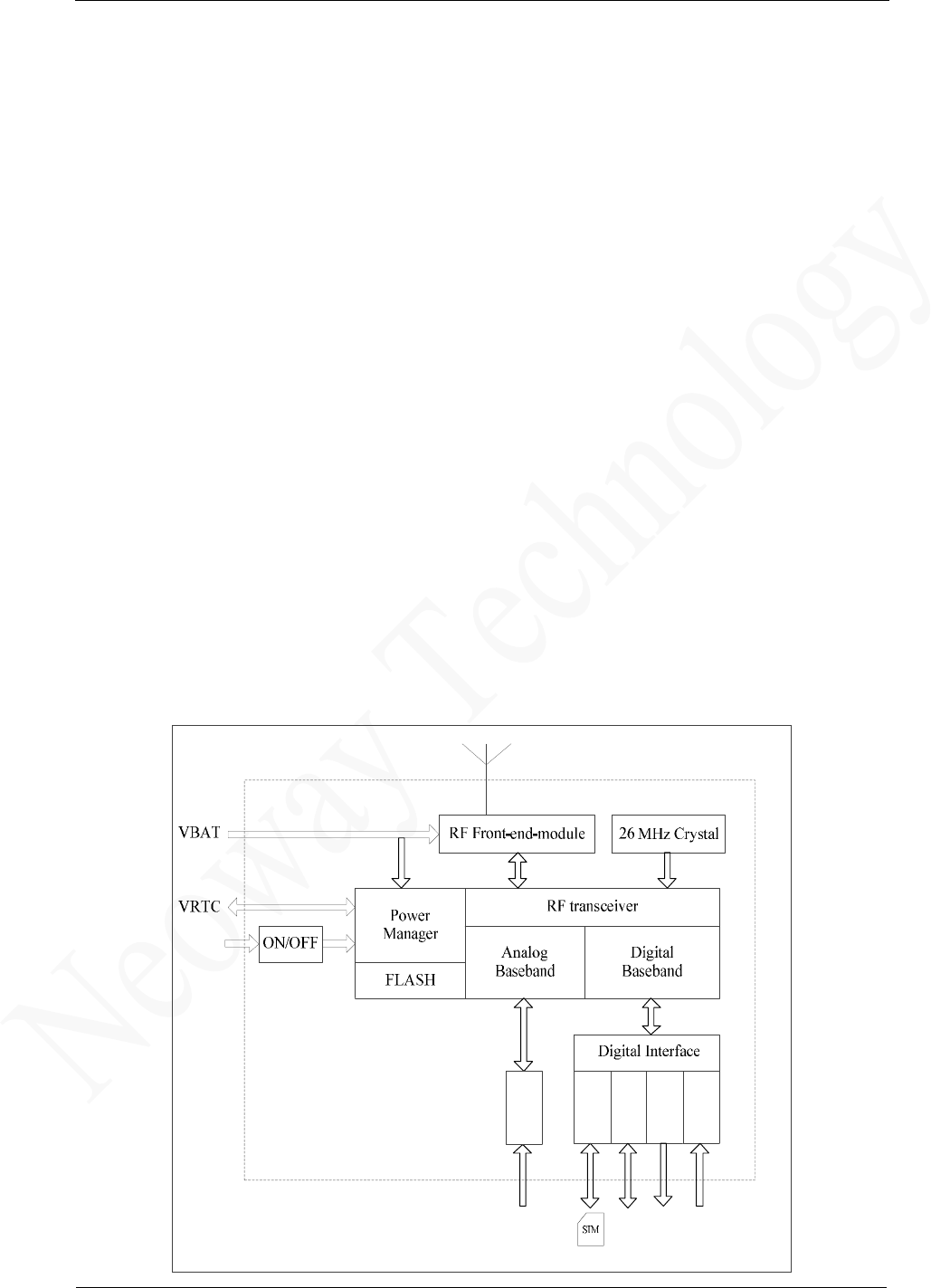
M590 GPRS Module Hardware User Guide
Copyright © Neoway Technology Co., Ltd 1
About This Document
This document defines the features, indicators, and test standards of the M590 module and provides
reference for the hardware design of each interface. With M590 GPRS Module AT Command Set, this user
guide can help you complete wireless communication application easily.
1 Introduction to M590
M590 is a compact wireless GPRS module that supports downlink EDGE. It can provide functions of SMS
and data services and is widely used in industrial and consumer fields.
1.1 Overview
Neoway M590 module adopts 21-pin LCC encapsulation and its dimensions are 27.6 mm x 21.6 mm x 2.6
mm. It provides customers the following hardware resources:
l UART interfaces, used for data communication, firmware updating and commissioning
l 10-bit ADC input, voltage ranging from 0 V to 2.8 V
l Adapting to 1.8 V and 3.0V SIM card
l Supporting RING/LIGHT/DTR (sleep mode) functions
l Supporting time updating
1.2 Block Diagram
The M590 module consists of baseband controller, Flash ROM, RF section, application interfaces, etc. All
sections coordinate with each other to provide such communication functions as GPRS data and voice.
The following figure shows the block diagram of M590.
DTR
RING
UART
ADC
SIM

M590 GPRS Module Hardware User Guide
Copyright © Neoway Technology Co., Ltd 2
1.3 Specifications
Table 1-1 M590specifications
Specifications Description
Band EGSM900/DCS1800 MHz dual-band
Supporting band locking
Sensitivity < -107 dBm
Max. transmit power l EGSM900 Class4(2W)
l DCS1800 Class1(1W)
Protocol Compatible with GSM/GPRS Phase 2/2+
AT l GSM07.07
l Extended AT commands
SMS l TEXT/PDU
l Supporting SMS message receiving and transmitting and alert for new
SMS messages
l Supporting SMS message management: reading/deleting/storage/list
GPRS feature l GPRS CLASS 12
l Max. theoretic uplink rate: 85.6 Kbit/s
l Max. theoretic downlink rate: 85.6 Kbit/s
l Built-in TCP/IP protocol, supporting multiple links
l Supporting server and client modes
Circuit Switch Data l CSD data service
l USSD
UART
l Supporting UART multiplexing
l Supporting AT sending, data transmission, and software download
l Supporting baudrate from 1200 bit/s to 115200 bit/s
CPU ARM7-EJ@360MHz
Antenna feature 50 Ω impedance
Operating temperature -40℃to +85℃
Operating voltage 3.5 V to 4.3 V (3.9 V is recommended)
Peak current Max 2.0 A
Idle current 18 mA
Current in sleep mode < 2 mA (live network)
< 1 mA (instrument, DRX=9)
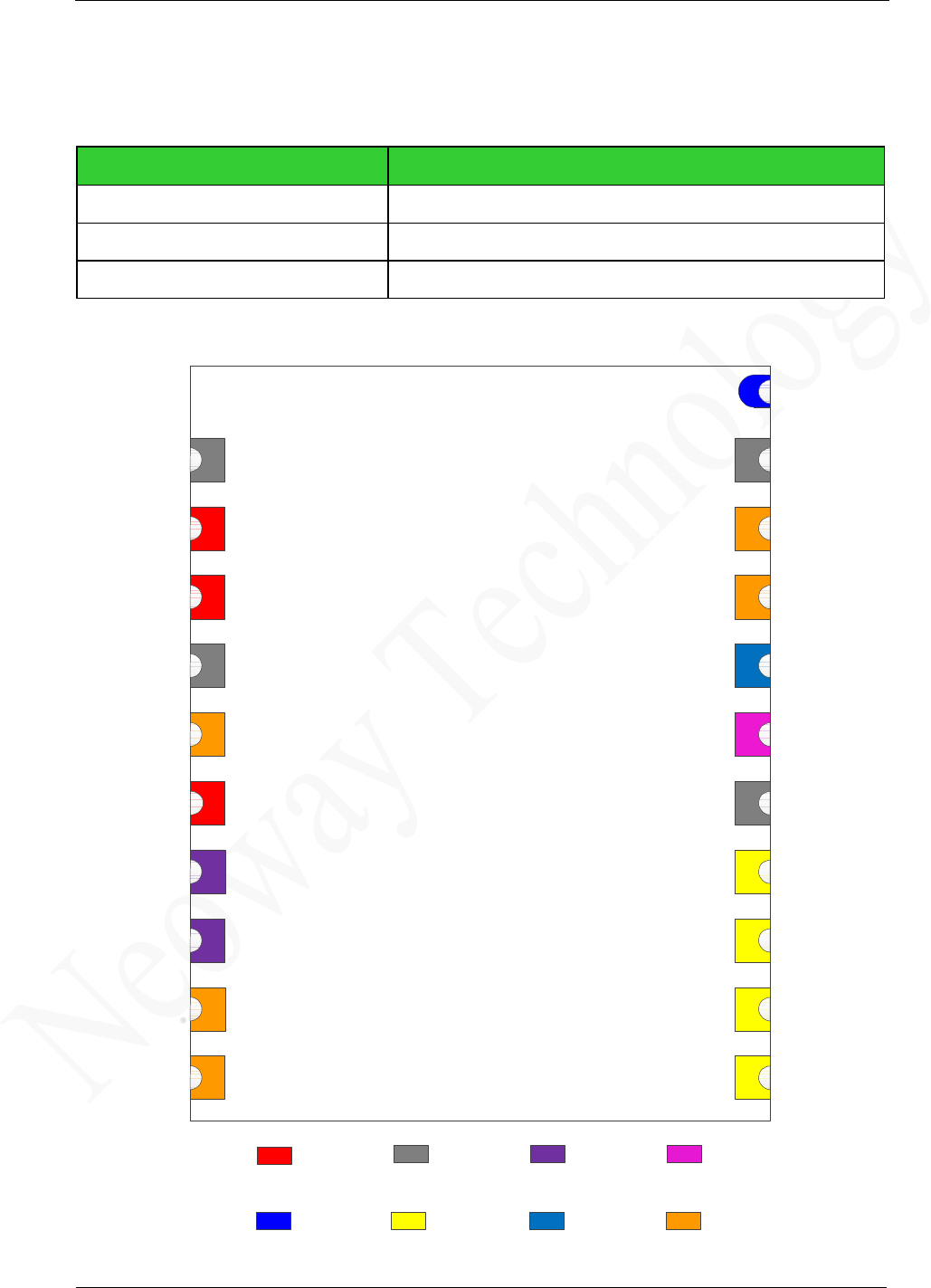
M590 GPRS Module Hardware User Guide
Copyright © Neoway Technology Co., Ltd 3
2 Pin Description and PCB Foot Print
2.1 Specifications and Encapsulation
Specifications M590
Dimensions 27.6 mm x 21.6 mm x 2.6 mm (H x W x D)
Weight 2.6 g
Encapsulation 21-pin LCC
Figure 2-1 Top view of the M590 module
SIMGPRS_ANT Other
NC
1
2
3
4
5
6
7
8
9
10 11
12
13
14
15
16
17
18
19
20
21
GND
VBAT
VBAT
GND
LIGHT
VDD_EXT
URXD
UTXD
DTR
RING SIM_DATA
SIM_CLK
SIM_RST
VSIM
GND
ADC_IN
NC
RESET
ON/OFF
GND
GPRS_ANT
Power GND UART ADC
M590
TOP View

M590 GPRS Module Hardware User Guide
Copyright © Neoway Technology Co., Ltd 4
2.2 Pin Definition
Table 2-1 M590 pin definition
Pin Name I/O Function Reset
Status
Level Feature
(V) Remarks
Power Supply and Switch Interfaces
2, 3 VBAT P Main power supply
input
3.5 V to 4.3 V (3.9 V
is recommended)
6 VDD_EXT P 2.8 V power supply
output
Supply power for IO
level shifting circuit.
Load capability: less
than 50 mA
1, 4,
15, 20 GND P Ground
19 ON/OFF DI On/Off input
0<VIL<0.6
2.1<VIH<VBAT
Low level pulse can
change the On/Off
state.
18 RESET DI Reset input
0<VIL<0.6
2.1<VIH<3.1
Internally pulled up
to 2.8V
Low level reset
UART Interface
7 URXD DI UART data receive
I/PU 0<VIL<0.6
2.1<VIH<3.1
0<VOL<0.42
2.38<VOH<2.8
With 47K pull-up
inside
8
UTXD DO UART data
transmit
SIM Card
11 SIM_DATA
DI/O
SIM card data IO
0<VIL<0.25*VSI
M,
0.75*VSIM<VIH
<VSIM
0<VOL<0.15*VS
IM
0.85*VSIM<VOH
<VSIM
Compatible with
1.8/3.0 V SIM card
12 SIM_CLK DO SIM card clock
output
13 SIM_RST DO SIM card reset
output
14 VSIM P SIM card power
supply output
LED Indicators
5 LIGHT DO Status LED I/PD
2.8 V/4 mA output
Sleep Mode Controlling
9 DTR DI Signal for
controlling sleep
mode I/PD
0<VIL<0.6
2.1<VIH<3.1
0<VOL<0.42
Low level by default
Used together with
AT commands

M590 GPRS Module Hardware User Guide
Copyright © Neoway Technology Co., Ltd 5
2.38<VOH<2.8
SMS and Incoming Call Ring
10 RING DO Ring output I/PD
0<VIL<0.6
2.1<VIH<3.1
0<VOL<0.42
2.38<VOH<2.8
Detect incoming
SMS messages or
calls
ADCDetecting
16 ADC_IN AI 10-bitADC input
Detectable voltage
range: 0 V to 2.8 V
GPRS Antenna
21 GPRS_ANT
AI/O
GPRS antenna
interface 50 Ω impedance
Reserved Pins
17 NC
Must be left
disconnected.
P: indicates power supply pins
NC: indicates pins that are not supported and must not be connected
DI: indicates digital signal input pins
DO: indicates digital signal output pins
I/PD: indicates digital signal input pins with pull-down
I/PU: indicates digital signal input pins with pull-up
AI: indicates analogy signal input pins
AO: indicates analogy signal output pins
The maximum input voltage at all IO ports (including peak signal current) cannot exceed 3.1 V because
the module uses a 2.8 V IO power system. In the application of the module, the IO output voltage from the
3.3 V power supply system of the external circuit might greatly overshoot 3.1 V due to the signal integrity
design. In this situation, the IO pins of the module might be damaged if the IO signals are connected to the
IO port on the 2.8-V system. To rectify this issue, take measures to match the level. For details, see the
Section 3.2 UART.
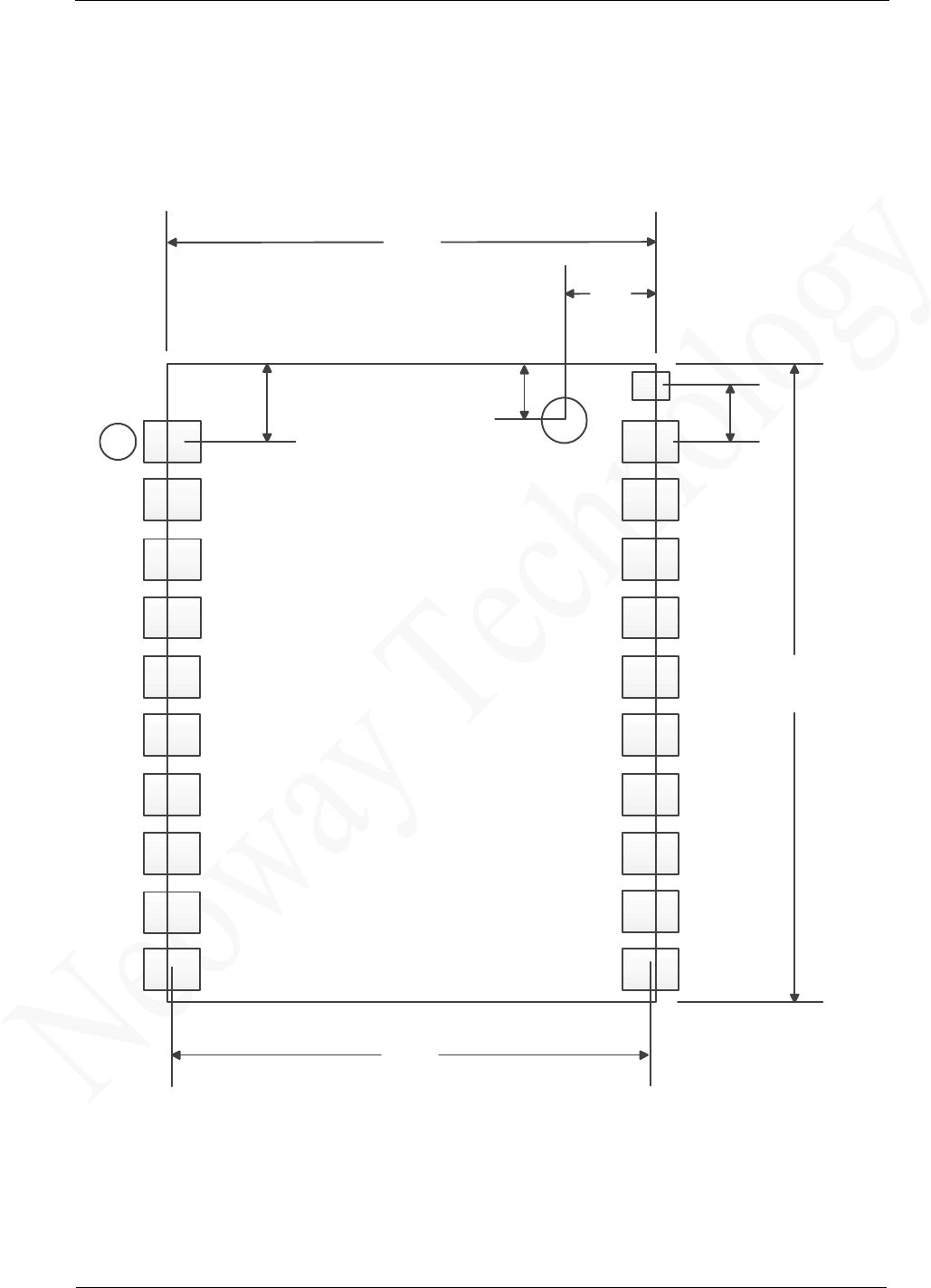
M590 GPRS Module Hardware User Guide
Copyright © Neoway Technology Co., Ltd 6
2.3 PCB Foot Print
LCC packaging is adopted to package the pins of the M590 module. Figure 2-2 shows the recommended
PCB foot print.
Figure 2-2 PCBfoot print recommended for M590 (unit: mm)
21.2
27.6
2.54
21.6
3.4
4.0
2.35
M590
Pads 1~20 : 1.8*2.4
Pad 21 : 1.2*1.6
Pitch: X=21.2;Y=2.54
Unit:mm
Copper Cut
D=2.0
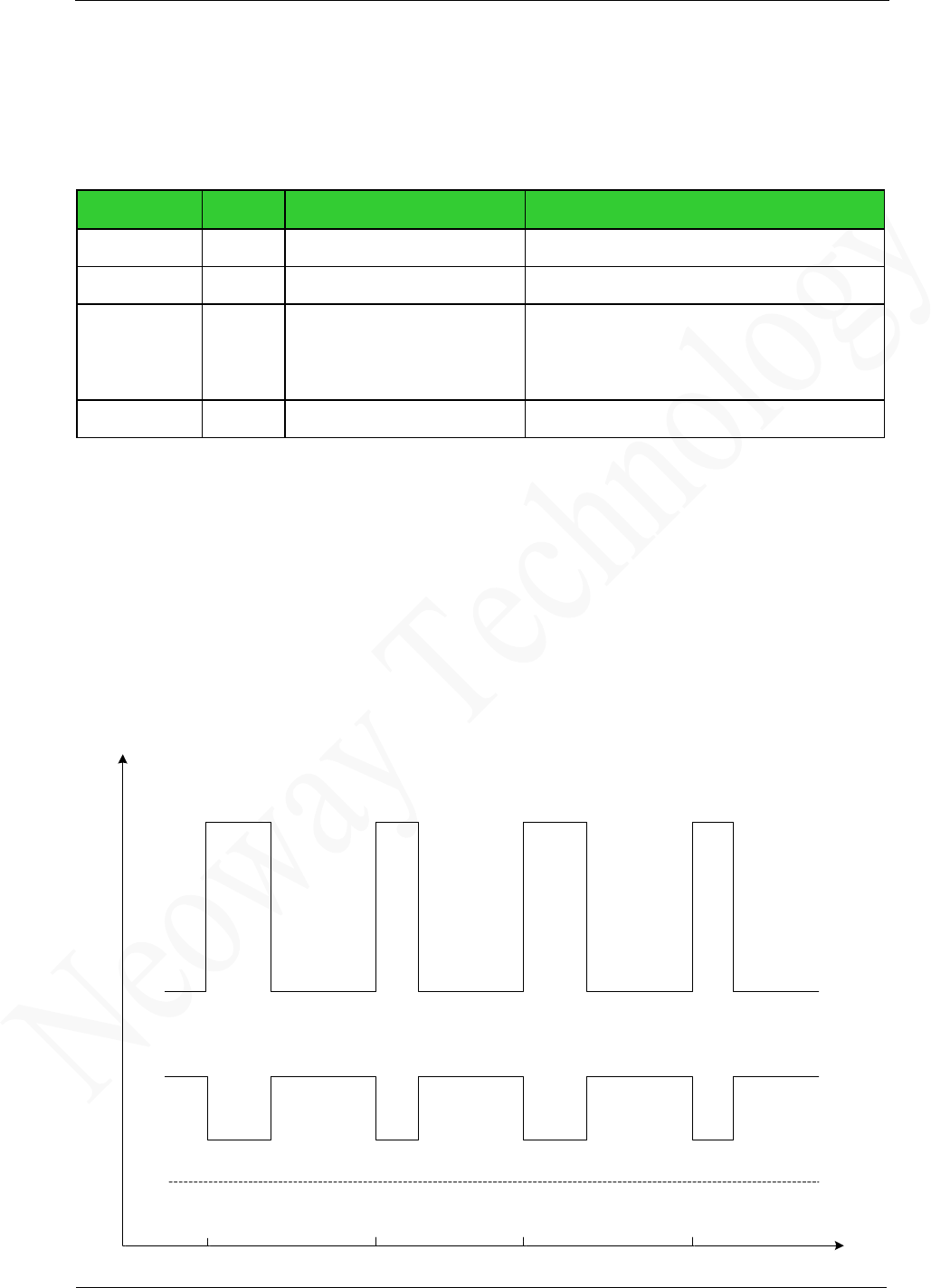
M590 GPRS Module Hardware User Guide
Copyright © Neoway Technology Co., Ltd 7
3 Interface Design
3.1 Power Supply and Switch Interfaces
Table 3-1 Power supply and switch interface
Signal I/O Function Remarks
VBAT P Main power supply input 3.5 V to 4.3 V (3.9 V is recommended)
VDD_EXT P 2.8 V power supply output Loading capability < 50 mA
RESET DI Module reset input Reset at low level
Min. 50 ms
100 ms is recommended
ON/OFF DI On/Off input Low level pulse can change the On/Off state.
3.1.1 Design Requirements
VBAT is the main power supply of the module. Its input voltage ranges from 3.5 V to 4.3 V and the
preferable value is 3.9V.It supplies power for baseband controller and RF power amplifier.
The performance of the VBAT power supply is a critical path to module's performance and stability. The
peak input current at the VBAT pin can be up to 2 A when the signal is weak and the module works at the
maximum transmitting power. The voltage will encounter a drop in such a situation. The module might
restart if the voltage drops lower than 3.5 V.
Figure 3-1 Current peaks and voltage drops
Keep above 3.5 V
Keep above 3.5 V
3.5 V
3.5 V
0 ms
0 ms 3.7 ms
3.7 ms 7.4 ms
7.4 ms 10.7 ms
10.7 ms T
T
2.0 A
2.0 A
Voltage
Voltage
Input
Current
Input
Current
3.9 V
3.9 V
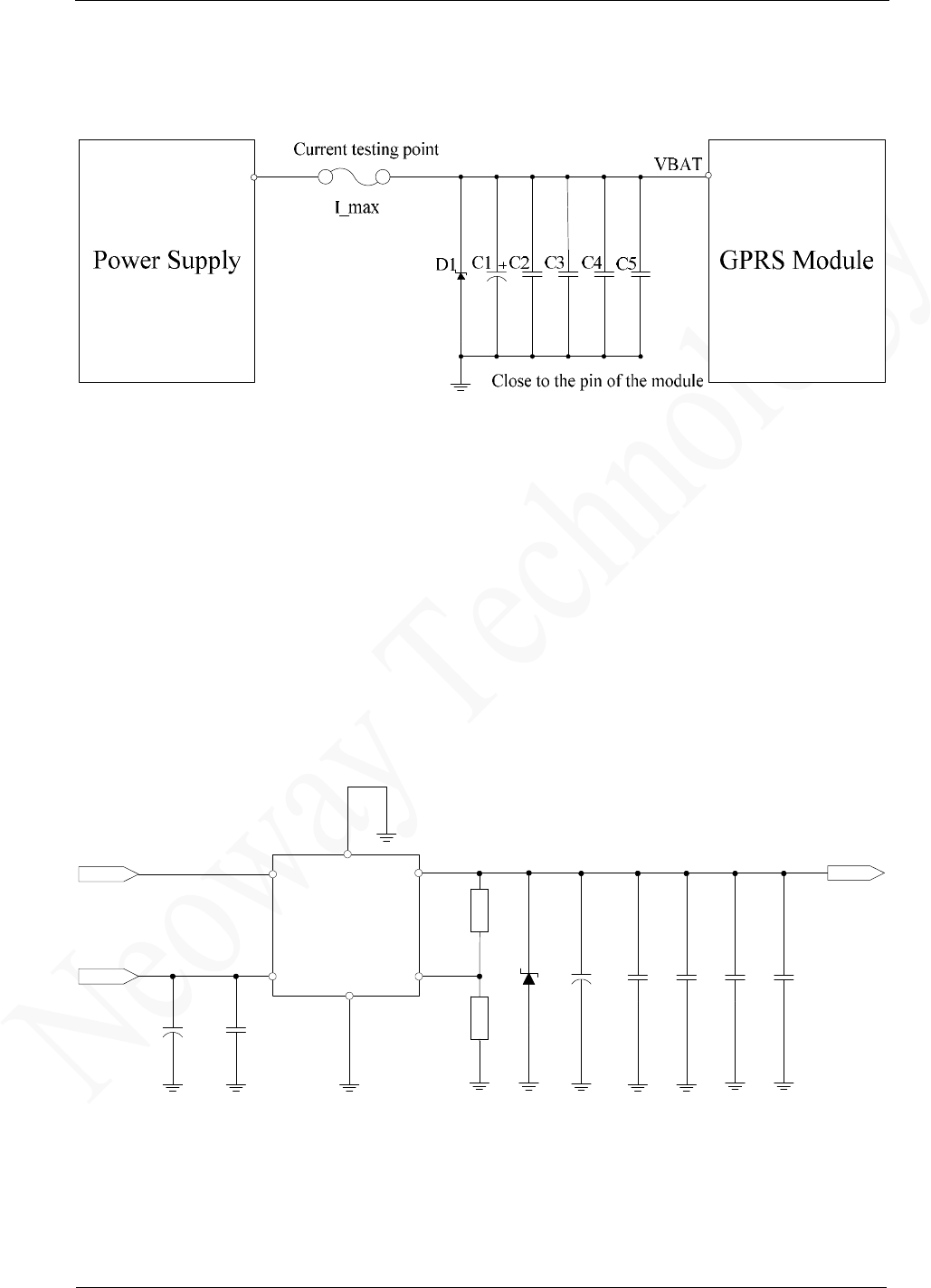
M590 GPRS Module Hardware User Guide
Copyright © Neoway Technology Co., Ltd 8
Figure 3-2shows a recommended power supply design for the module.
Figure 3-2 Capacitors used for the power supply
In the circuit, you can use TVS at D1 to enhance the performance of the module during a burst. SMF5.0AG
(Vrwm=5V&Pppm=200W) is recommended.A large bypass tantalum capacitor (220 μF or 100μF) or
aluminum capacitor (470 μF or 1000 μF) is expected at C1 to reduce voltage drops during bursts together
with C2 (10μF capacitor). In addition, you need to add 0.1 μF, 100 pF, and 33 pF filter capacitors to enhance
the stability of the power supply.
A controllable power supply is preferable if used in harsh conditions. The module might fail to reset in
remote or unattended applications, or in an environment with great electromagnetic interference (EMI). You
can use the EN pin on the LDO or DC/DC chipset to control the switch of the power supply as shown in
Figure 3-3.
MIC29302WU in the following figure is an LDO and outputs 3 A current to ensure the performance of the
module.
Figure 3-3 Reference design of power supply control
The alternative way is to use a p-MOSFET to control the module's power, as shown in Figure 3-4. When
the external MCU detects the exceptions such as no response from the module or the disconnection of
GPRS, power off/on can rectify the module exceptions.In Figure 3-4, the module is powered on when
GPRS_EN is set to high level.
VCC_IN_5V
GPRS_EN VBAT
100 uF
TAN 0.1 uF
TVS
5V 10 uF
470uF
TAN
10K
4.75K
VOUT
MIC29302WU
EN
VIN ADJ
0.1 uF 100pF 33pF
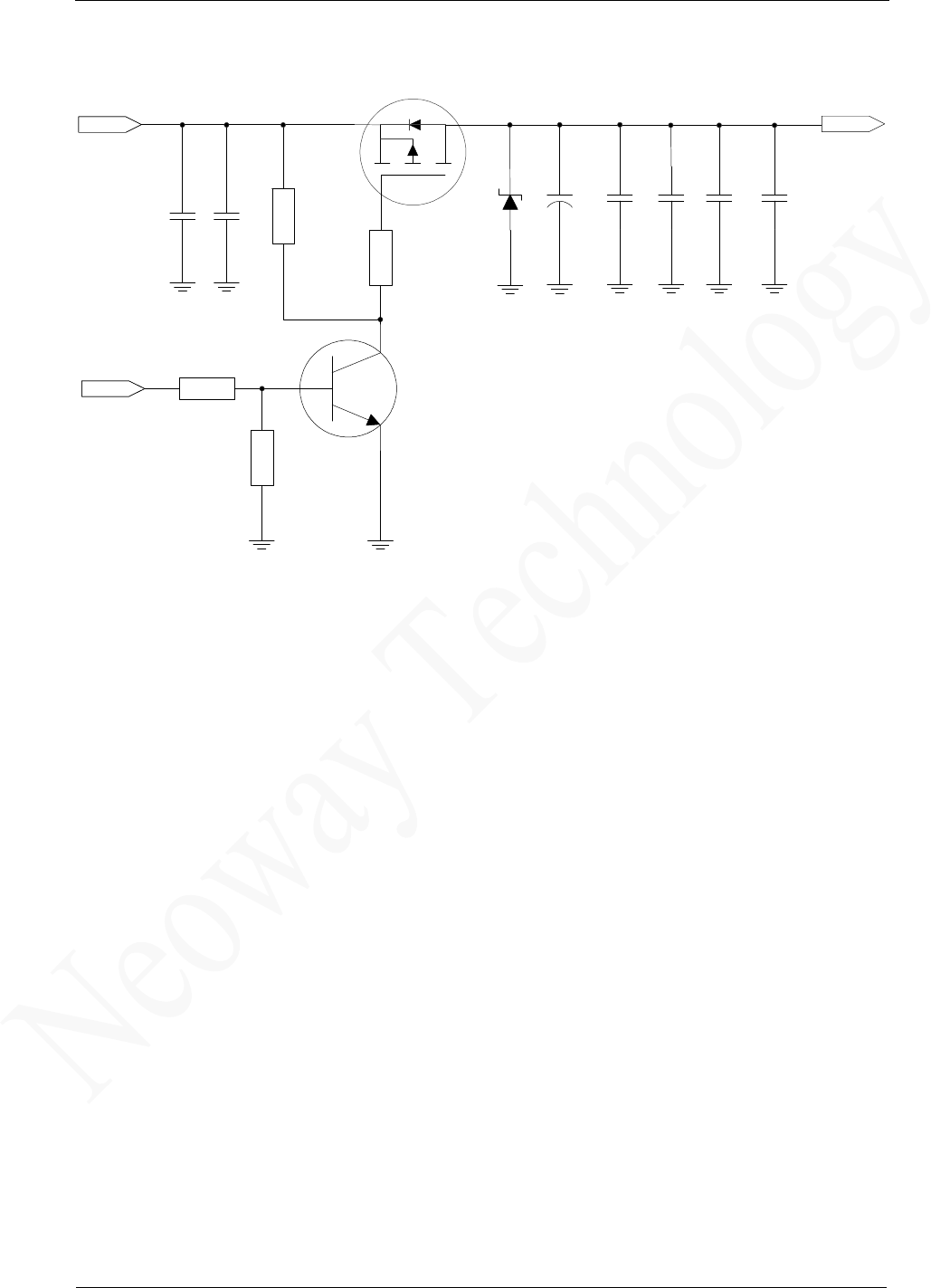
M590 GPRS Module Hardware User Guide
Copyright © Neoway Technology Co., Ltd 9
Figure 3-4 Reference design of power supply controlled by p-MOSFET
Q2 is added to eliminate the need for a high enough voltage level of the host GPIO.In case that the GPIO can
output a high voltage greater than VCC_IN_3.9V - |VGS(th)|, where VGS(th) is the Gate Threshold Voltage, Q2
is not needed.
Reference components:
l Q1 can be IRML6401 or Rds(on) p-MOSFET which has higher withstand voltage and drain current.
l Q2: a common NPN transistor, e.g. MMBT3904; or a digital NPN transistor, e.g. DTC123.If digital
transistor is used, delete R1 and R2.
l C3: 470 uF tantalum capacitor rated at 6.3V; or 1000 uF aluminum capacitor.If lithium battery is
used to supply power, C3 can be 220 uF tantalum capacitor.
Protection
Place a TVS diode (VRWM=5 V) on the VBAT power supply to ground, especially in automobile
applications. For some stable power supplies, zener diodes can decrease the power supply overshoot.
MMSZ5231B1T1G from ONSEMI and PZ3D4V2 from Prisemi are options.
Trace
The trace width of primary loop lines for VBAT on PCB must be able to support the safe transmission of 2A
current and ensure no obvious loop voltage decrease.Therefore, the trace width of VBAT loop line is
required 2 mm and the ground should be as complete as possible.
Separation
As shown in Figure 3-1, the GPRSmodule works in burst mode that generates voltage drops on power
supply. And furthermore this results in a 217Hz TDD noise through power (One of the way generating
noise.Another way is through RF radiation). Analog parts, especially the audio circuits, are subjected to this
noise, known as a "buzz noise" in GSM systems.To prevent other parts from being affected, it's better to use
S
G
D
VCC_IN_3.9V VBAT
10K
100K 33 pF
10 uF
GPRS_EN
2K
10K
0.1 uF
Q1
R4
C1 C2 C4 C5 C7
R1
R2
10 uF0.1 uF
R3
Q2
TVS
5V 470 uF
C3 C6
100pF
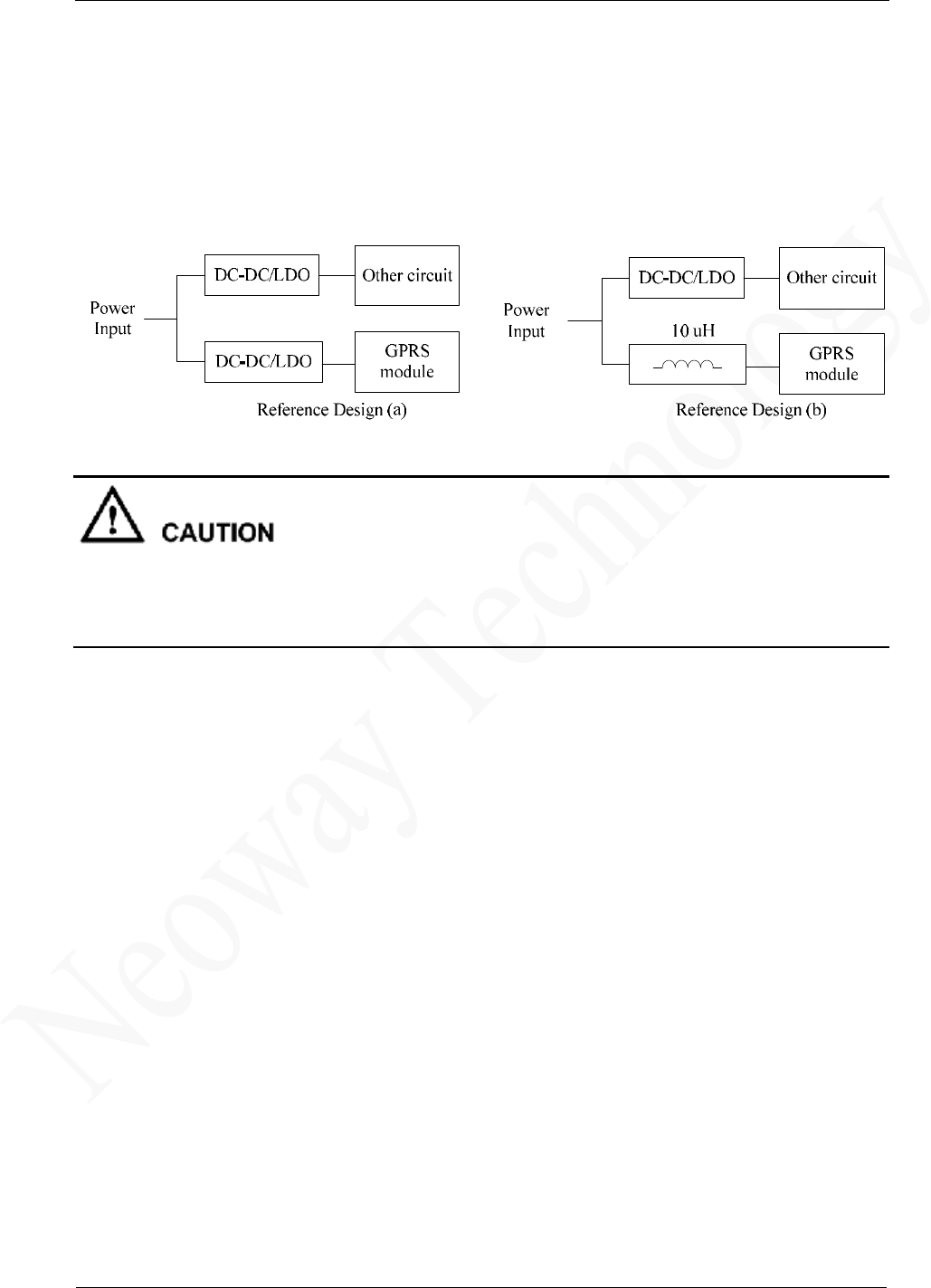
M590 GPRS Module Hardware User Guide
Copyright © Neoway Technology Co., Ltd 10
separated power supplies.The module shall be supplied by an independent power, like a DC/DC or LDO.
See Figure 3-5.
DC/DC or LDO should output rated peak current larger than 2 A.
The inductor used in Reference Design (b), should be a power inductor and have a very low resistance. 10
uH with average current ability greater than 1.2A and low DC resistance is recommended.
Figure 3-5 Reference designs of separated power supply
Never use a diode to make the drop voltage between a higher input and module power. Otherwise,
Neoway will not provide warranty for product issues caused by this. In this situation, the diode will
obviously decrease the module performances, or result in unexpected restarts, due to the forward voltage
of diode will vary greatly in different temperature and current.
EMC Considerations
Place transient overvoltage protection components like TVS diode on power supply, to absorb the power
surges. SMAJ5.0A/C could be a choice.
3.1.2 VDD_EXT
It is recommended that VDD_EXT is only used for interface level transformation. VDD_EXT can output
2.8 V and 50 mA. It stops output after the module is shut down.
3.1.3 Power-On/OffControl and Procedure
Prior to turning on the module, power on the host MCU and finish the UART initialization.Otherwise
conflictions may occur during initialization, due to unstable conditions.
ON/OFF is a low level pulse active input, used to turn on or off the module.
Power-On Procedure
While the module is off, drive the ON/OFF pin to ground for at least 1.2 second and then release, the
module will start. An unsolicited message (+MODEM:STARTUP) will be sent to host through UART port,
indicating that the module is powered on and can respond to AT commands.
When you design your program, you can use the unsolicited message (MODEM:STARTUP) to check
whether the module is started or reset improperly.
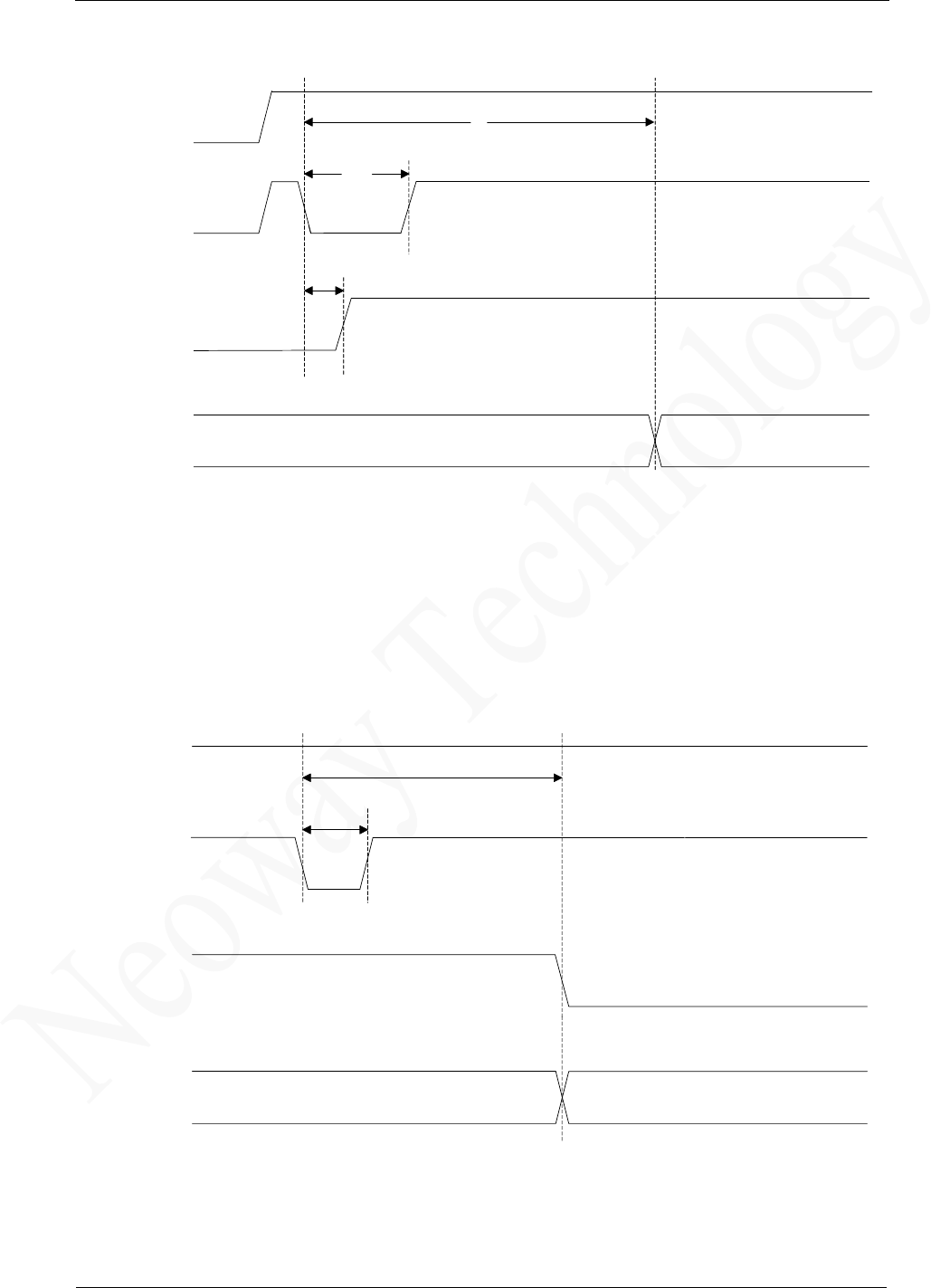
M590 GPRS Module Hardware User Guide
Copyright © Neoway Technology Co., Ltd 11
Figure 3-6 Power-on procedure
Power-Off Procedure
While the module is on, drive the ON/OFF pin to ground for at least 500 ms and then release, the module
will try to detach to network and normally 2 seconds later it will shut down. Another approach to turn off the
module is using AT commands. For details, see M590 GPRS Module AT Commands. Figure 3-7 shows the
power-off procedure of the module.
Figure 3-7 Power-off procedure
Power-On/Off Control
Figure 3-8 shows a reference circuit for ON/OFF control with inverted control logic.
VBAT
ON/OFF
VDD_EXT
UART
1.2s
3s
300 ms
VBAT
ON/OFF
VDD_EXT
UART
2 s
500 ms
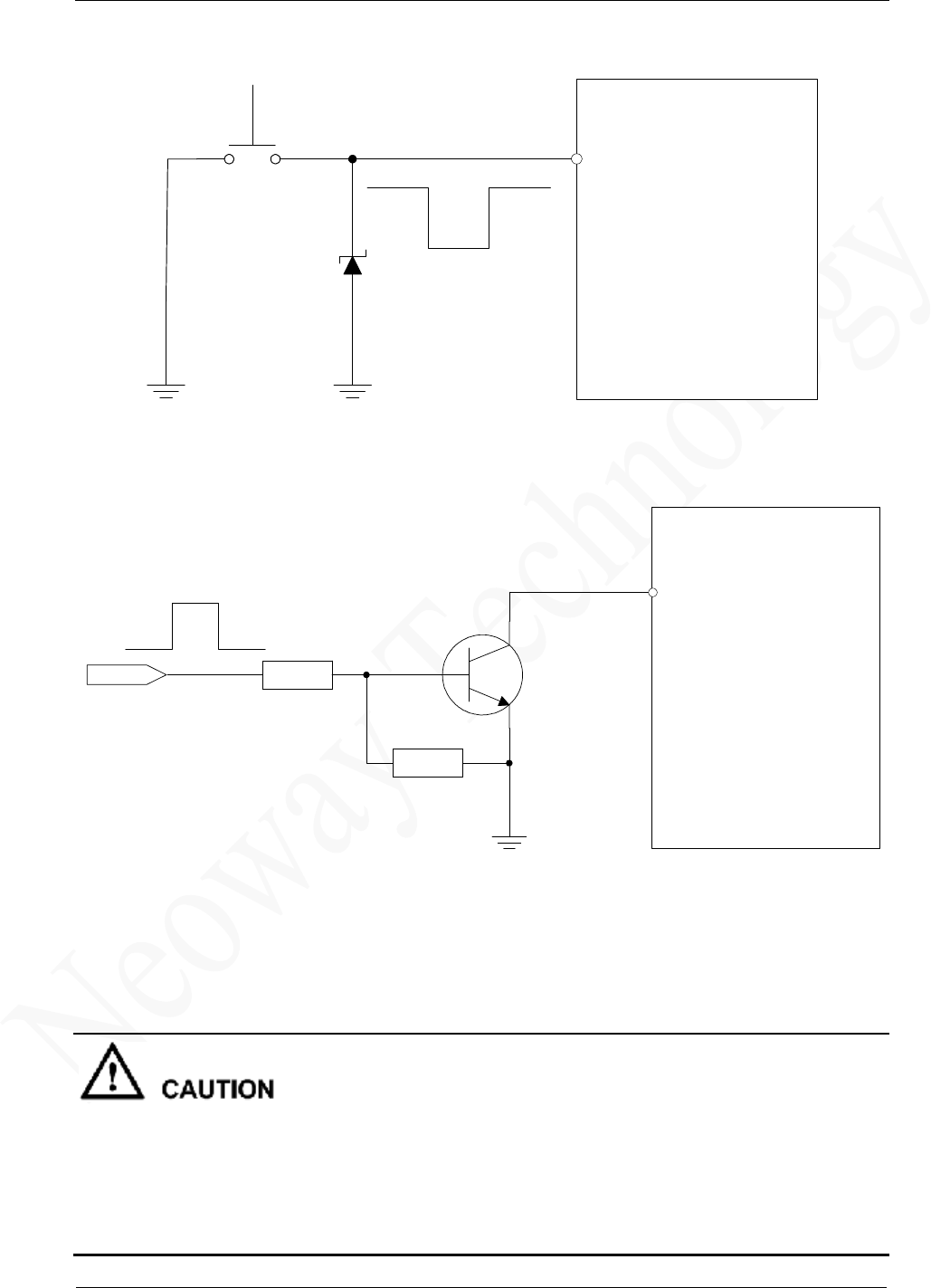
M590 GPRS Module Hardware User Guide
Copyright © Neoway Technology Co., Ltd 12
Figure 3-8 Reference circuit for power-on/off control
Figure 3-9 Reference circuit for power-on/off controlled by high level
In Figure 3-9, high level takes effect for ON/OFF on the user side (USER_ON) after level shifting.
R1 and R2 can be adjusted according to the driving capability of the USER_ON pin.
Use a common NPN transistor, e.g. MMBT3904; or a digital NPN transistor, e.g. DTC123.If digital
transistor is used, delete R1 and R2.
l Level abnormalities at interfaces connected to the external MCU, especially the UART port, might
affect the power-on procedure of the module. For example, when a module is turned on, the IO ports
of the MCU are still in output status because they have not been initialized completely. The module
might fails to start if the UTXD signal (output pin) is forced to pull up or down.
l The better way to rescue the module from abnormal condition, is to apply a power OFF-ON procedure,
rather than using the ON/OFF control signal. In fact ON/OFF signal is software-dependent.
GPRS Module
ON/OFF
TVS
S 1
USER_ON GPRS Module
ON/OFF
4.7K
47K
R1
R2
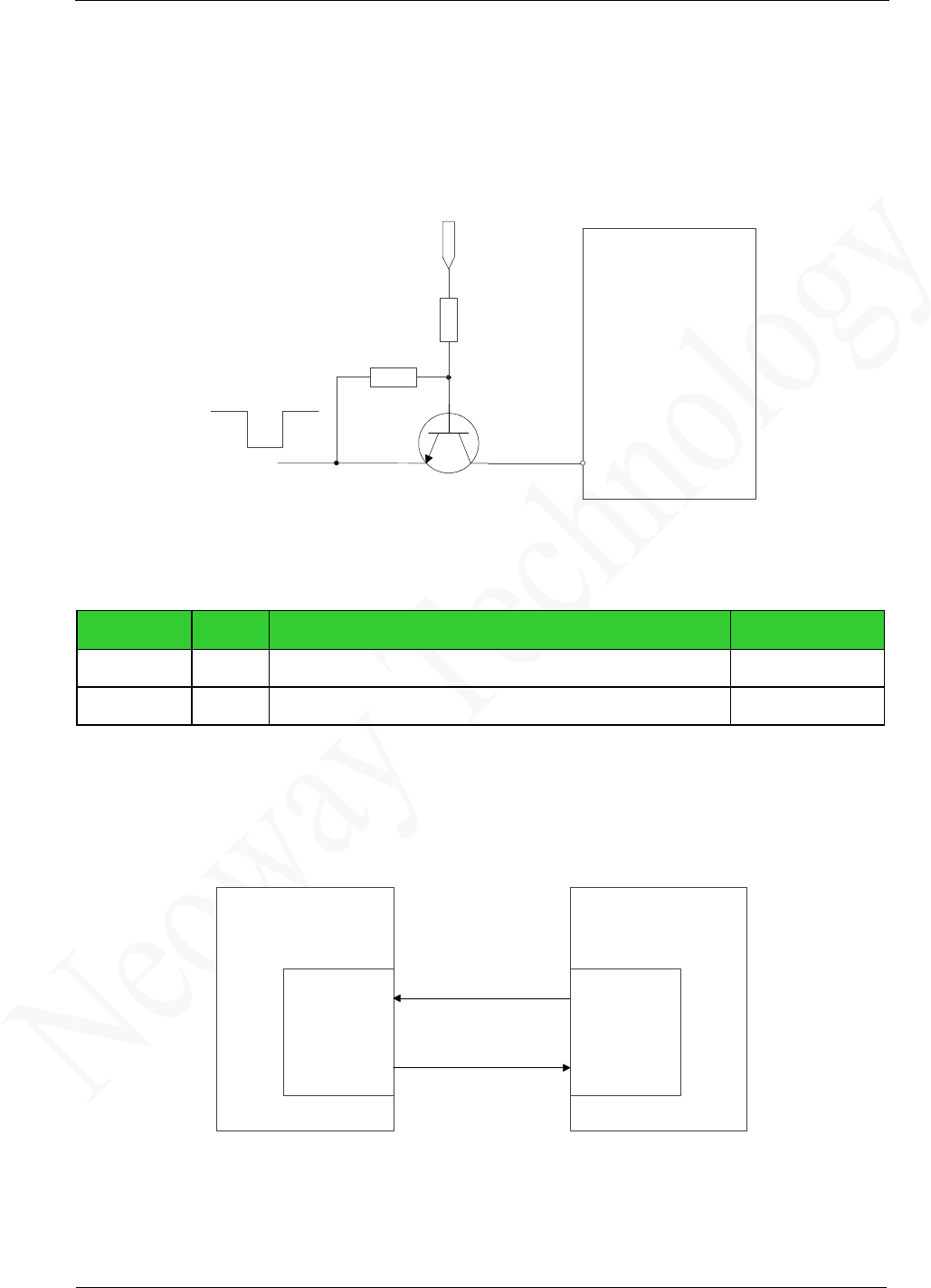
M590 GPRS Module Hardware User Guide
Copyright © Neoway Technology Co., Ltd 13
3.1.4 RESET
You can reset the module by keeping the RESET pin low level for more than 100 ms.The pin is pulled up by
an internal resistor and the typical high level is 2.8 V. The RESET pin can be left disconnected if not used. If
you use 3.3 V IO system, you are advised to separate it by using triode. Please refer to Figure 3-10.
Figure 3-10 Reset circuitwith triode separating
3.2 UART
Table 3-2 UART
Signal I/O Function Description Remarks
URXD DI UART data receive
UTXD DO UART data transmit
UART is used for AT commands, data sending/receiving, firmware updating, etc. Figure 3-11shows the
signal connection between the module (DCE) and the terminal (DTE).
Figure 3-11 Signal connection between DCE and DTE
The UART of M590works at 2.8 V CMOS logic level. The voltages for input high level should not exceed
3.1 V. Supported baud rates are 1200, 2400, 4800, 9600, 14400, 19200, 38400, 57600, 115200 bit/s, and the
default rate is 115200 bit/s.
RESET
VDD_EXT
4.7K
47K GPRS Module
DCE
URXD
UTXD
DTE
UTXD
URXD
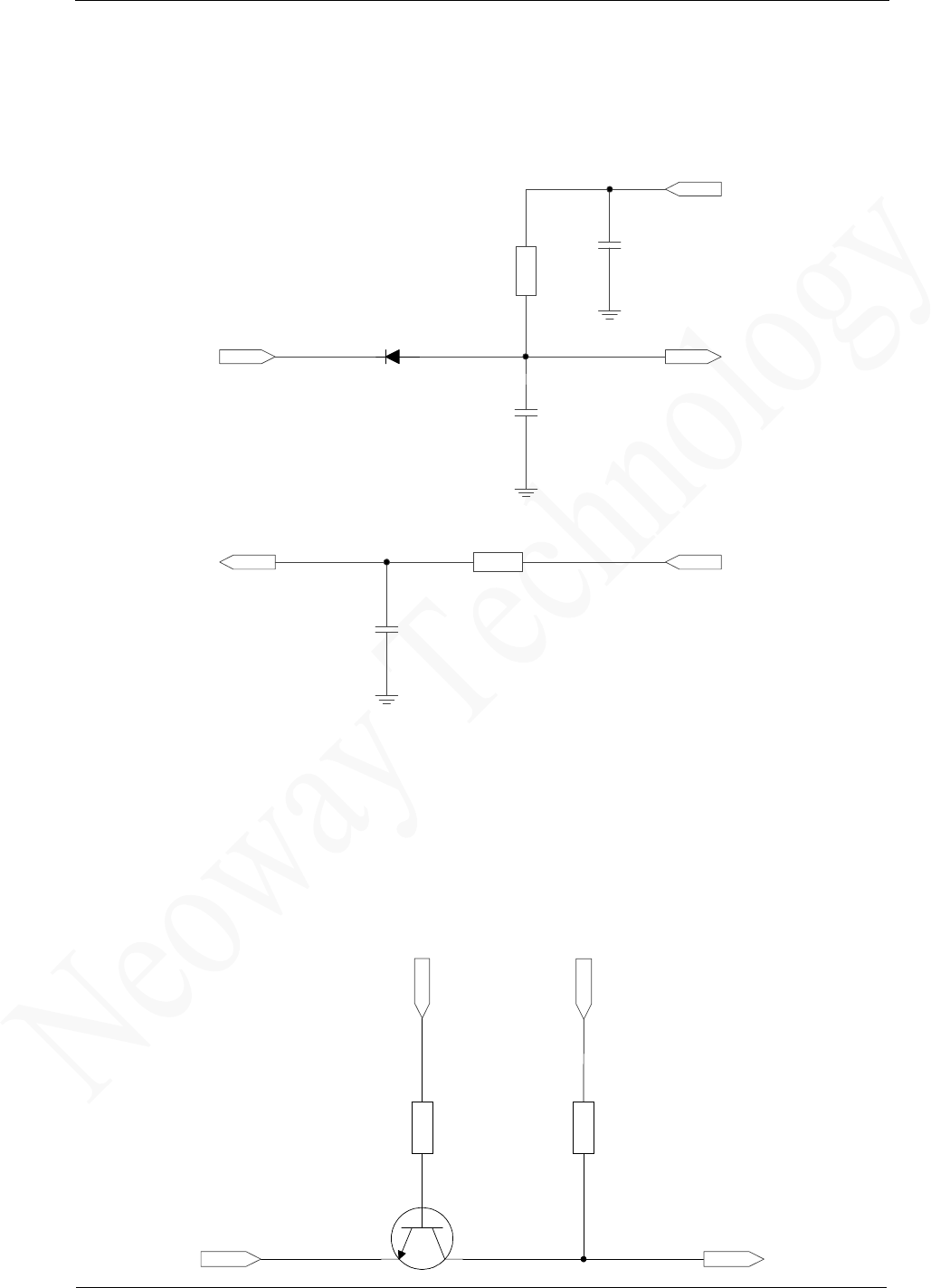
M590 GPRS Module Hardware User Guide
Copyright © Neoway Technology Co., Ltd 14
If the UART is interfacing with a MCU that has 3.3V logic levels, it is recommended that you add a level
shifting circuit outside of the module.
Figure 3-12 Recommended circuit for the communication between 3.3V MCU and UART
In Figure 3-12, 100 pF filter capacitor should be placed near the receive pin of the module. Resistance (200
Ω to 470 Ω) and capacity (100 pF to 470 pF) can be selected based on the tested signal wave. Great serial
resistance and filter capacity will decrease the signal level, resulting in great signal wave distortion and the
low adaptable UART communication baudrate. RB521S-30TE-61, RB521SM-30GJT2R, and
LRB521S-30T1G are recommended for separating diode.
When the external MCU adopts 5 V IO system, level shifting is required for both UART receive and
transmit.Figure 3-13shows a reference circuit.
Figure 3-13 Recommended circuit for the communication between 5V MCU and UART
Module_URXD
Module_UTXD
VDD_EXT
0.1 uF
47K
RB521S
200
33 pF
33 pF
MCU_UTXD
MCU_URXD
INPUT OUTPUT
VCC_IN VCC_OUT
4.7K 10K
Q1
R2 R3

M590 GPRS Module Hardware User Guide
Copyright © Neoway Technology Co., Ltd 15
In Figure 3-13, INPUT is connected to UTXD of the MCU and VCC_IN is connected to the 5 V power
supply of the MCU. OUTPUT is connected to URXD of the module and VCC_OUT is connected to
VDD_EXT(2.8V) of the module.If the circuit is far away from the VDD_EXTpin, add a 0.1 μF decoupling
capacitor to VCC_OUT.
Level shifting between URXD of the MCU and UTXD of the module can be implemented in the same way.
The pull-up resistor R3 ranges from 4.7 K to 10 K; R2 ranges from 2 K to 10 K.Resistors are selected based
on the voltage of the power supply and UART baudrate. You can select resistors with great resistance to
reduce the power consumption when the power supply has great voltage or the baudrate is low. But, the
resistance will affect the quality of the square wave.In addition, the circuit performance is affected by the
signal traces during PCB layout.
It is recommended that you choose a high-speed NPN transistor because the Q1 switch rate will affect the
wave quality after level shifting.MMBT3904 or MMBT2222 is recommended.
Avoid data produced at UART when the module is powered on. You are advised to send data to the UART
3 seconds after the module is powered on so that the module would not respond wrongly.
3.3 DTR and RING
Table 3-3 DTR and RING pins
Signal I/O Function Remarks
DTR DI Signal for controlling sleep mode Left disconnected if not used
RING DO Ring output Left disconnected if not used
3.3.1 DTR Pin
Generally DTR is used for sleep mode control. It works with AT commands. For details, see M590GPRS
Module AT CommandSet.Based on the setting of the selected mode, pulling DTR low will bring the module
into sleep mode. In this mode, the idle current is less than 2 mA, the module can also respond to the
incoming call, SMS, and GPRS data.The host MCU can also control the module to exit sleep mode by
controlling DTR.
Process of entering the sleep mode:
1. Keep DTR high level in working mode. Activate the sleep mode by using the
AT+ENPWRSAVE=1command.
2. Pull DTR low, and the module will enter sleep mode, but only after process and pending data
finished.
3. In sleep mode, the module can be woken up by the events of incoming voice call, received data, or
SMS. Meanwhile the module will send out the unsolicited messages by the interface of RING or
UART.
Upon receipt of the unsolicited messages, the host MCU should pull DTR high firstly, otherwise the
module will resume sleep mode shortly. And then the host MCU can process the voice call, received
data, or SMS.After processing is finished, pull DTR low again to put the module into sleep mode.
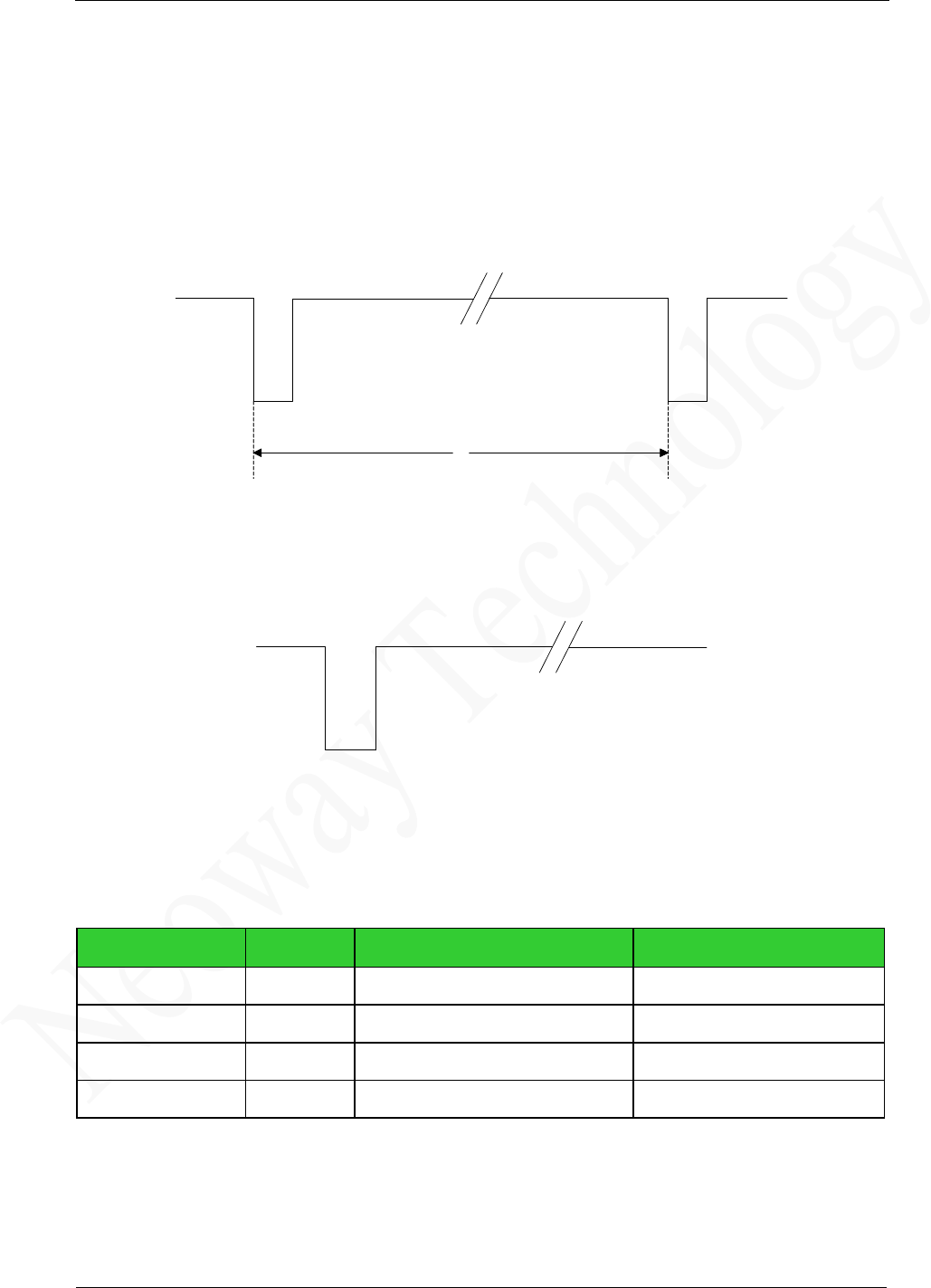
M590 GPRS Module Hardware User Guide
Copyright © Neoway Technology Co., Ltd 16
4. Pull DTR high, the module will exit from sleep mode actively, and furthermore enable the UART.
Thus the voice call, received data, or SMS can be processed through UART.After processing
finished pull it low again, to take the module back to sleep mode.
3.3.2 RING Signal Indicator
l Calling: Once a voice call is coming, UART output "RING" character strings and meanwhile the
RING pin outputs 30 ms low pulses at 5s period. After the call is answered, the high level restores.
Figure 3-14 RING indicator for incoming call
l SMS: Upon receipt of SMS, the module outputs one 35ms low pulse.
Figure 3-15 RING indicator for SMS
3.4 SIM Card Interface
Table 3-4 SIM Card Interface
Signal I/O Function Description Remarks
VSIM P SIM card power supply output 1.8V/3.0V
SIM_CLK DO SIM card clock output
SIM_RST DO SIM card reset output
SIM_DATA DI/O SIM card data IO Internal pull-up
M590 supports 3.0 V and 1.8 V SIM cards. VSIM supplies power for SIM card with 30mA.
SIM_DATA is internally pulled up by a resistor. External pull-up resistor is not needed.
SIM_CLK can work at several frequenciesat 3.25MHz typically.
5s
30 ms 30 ms
35 ms
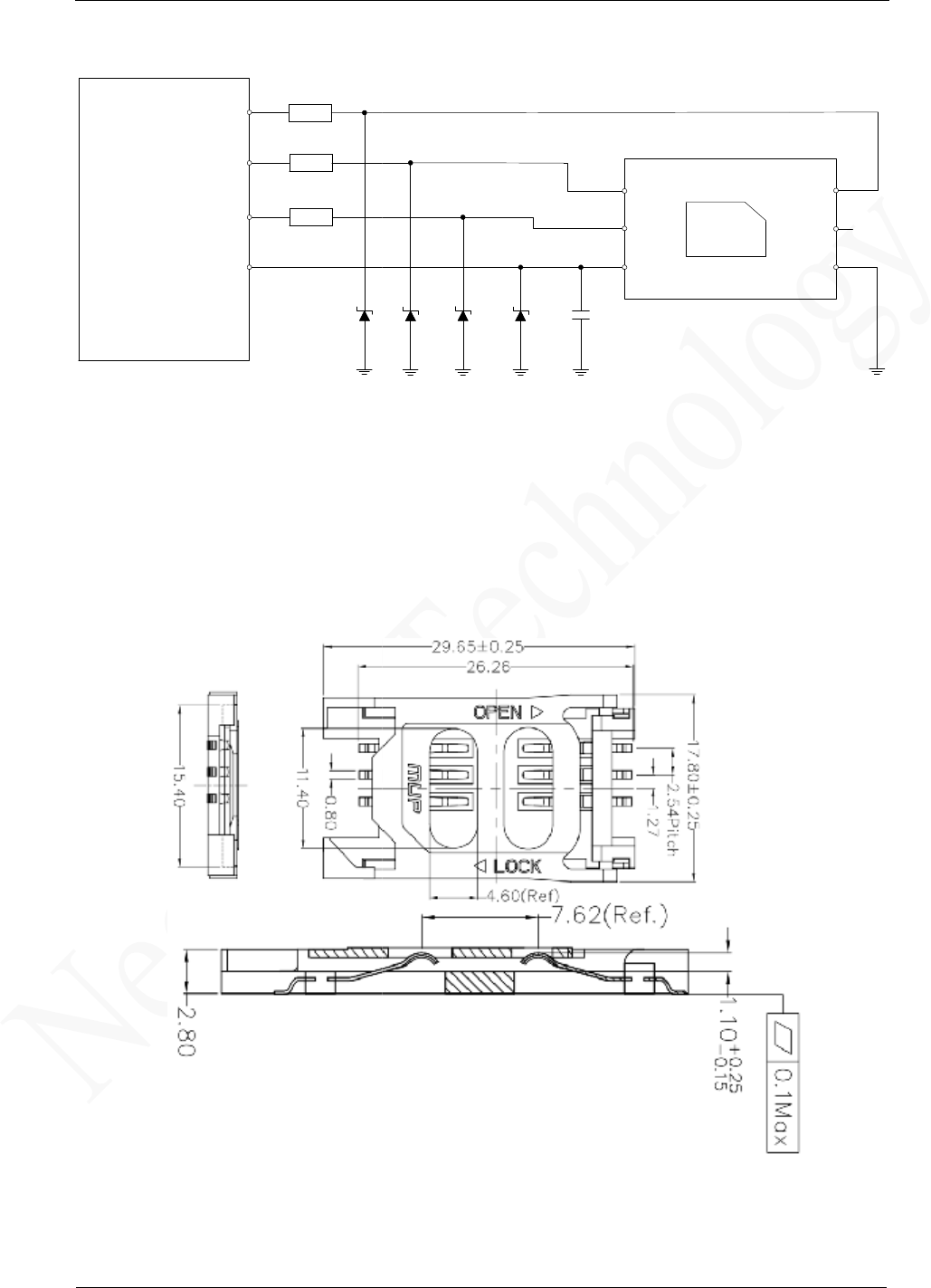
M590
GPRS Module Hardware User Guide
Copyright © Neoway Technology Co., Ltd
Figure 3-16
ESD protectors, such as ESD diodes (lower than 33 pF) or
signals, especially in automotive electronics or other applications with badly ESD.
replace ESD diodes with 27 pF to 33 pF grounding capacitors.
be close to SIM card.
If you use 6-pin SIM card sockets
, MCP
encapsulation.
Figure 3
20
20
20
SIM_DATA
SIM_CLK
SIM_RST
VSIM
GPRS
Module
GPRS Module Hardware User Guide
Copyright © Neoway Technology Co., Ltd
Reference design of SIM card interface
ESD protectors, such as ESD diodes (lower than 33 pF) or
ESD varistors, are recommended on the SIM
signals, especially in automotive electronics or other applications with badly ESD.
In other applications,
replace ESD diodes with 27 pF to 33 pF grounding capacitors.
The ESD diodes or small capacitors should
, MCP
-C713(H2.8) is recommended. Figure 3-17
shows its
Figure 3
-17 Reference of SIM card socket
1 uF
CLK
RST
VCC
GND
SIM卡
DATA
17
ESD varistors, are recommended on the SIM
In other applications,
The ESD diodes or small capacitors should
shows its
VPP
GND
DATA
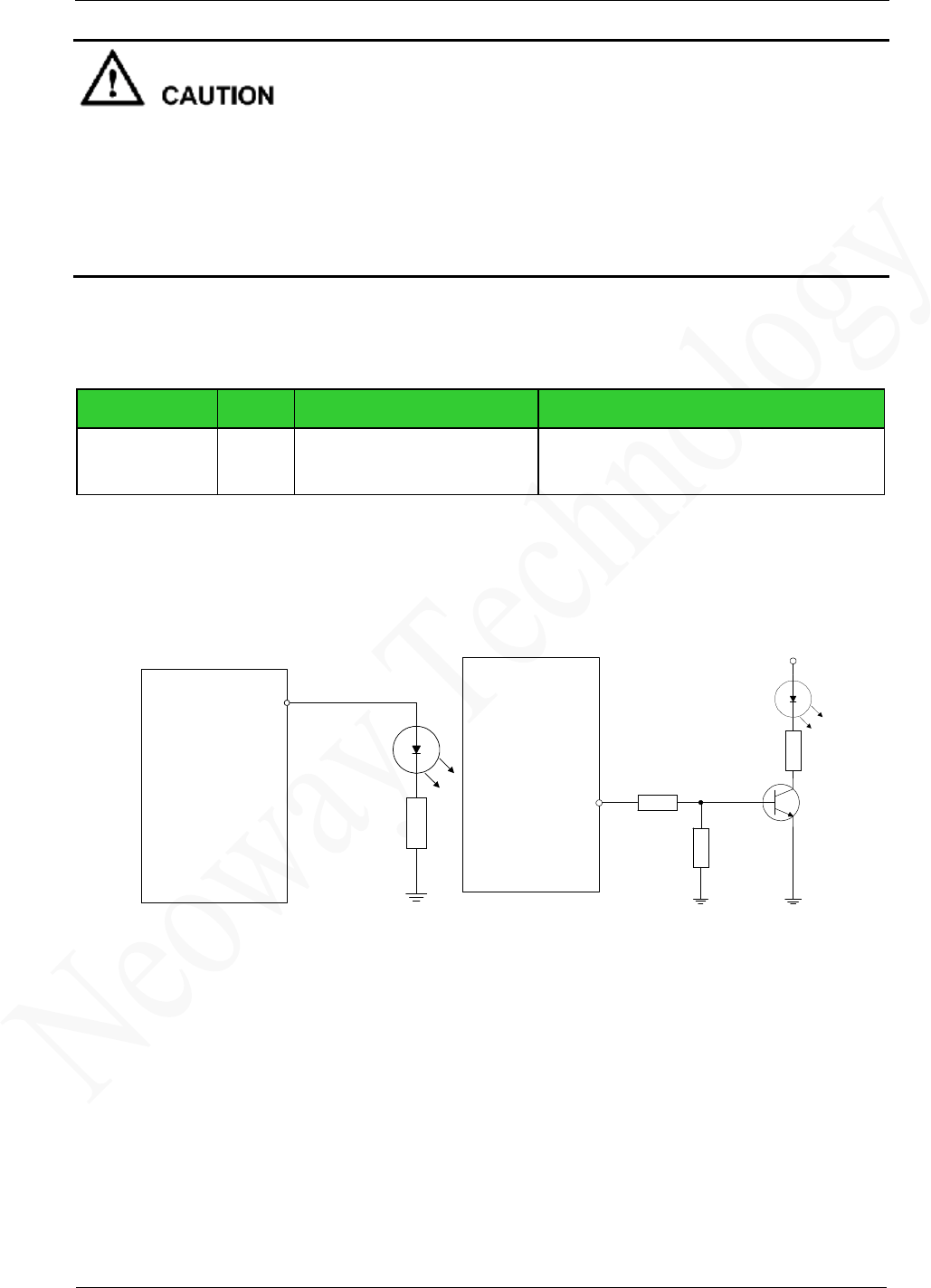
M590 GPRS Module Hardware User Guide
Copyright © Neoway Technology Co., Ltd 18
SIM card is sensitive to GSM TDD noise and RF interference. So, the PCB design should meet the
following requirements:
l The antenna should be installed far away from the SIM card and SIM card traces, especially to the
build-in antenna.
l The SIM traces on the PCB should be as short as possible and shielded with GND copper.
l The ESD diodes or small capacitors should be closed to SIM card on the PCB.
3.5 Running LED Indicator
Table 3-5 LED indicator
Signal I/O Function Remarks
LIGHT DO Indicates running status 2.8 V output, max. 4 mA
High level drives the LED indicator
The LIGHT pin can output a 4 mA current and 2.8 V voltage, therefore the LED can be directly connected
to this pin with a resistor in series.For better luminance, drive the LED with a transistor instead.
Figure 3-18 LED indicator
When the module is running, the LED indicator is driven by the LIGHT to indicate different module status
with its various blink behaviors. You can set the blink mode by AT commands. For more details, see M590
GPRS Module AT Command Set.
LIGHT
GPRS
Module 1K LIGHT
GPRS Module
10K
VCC
470
4.7K
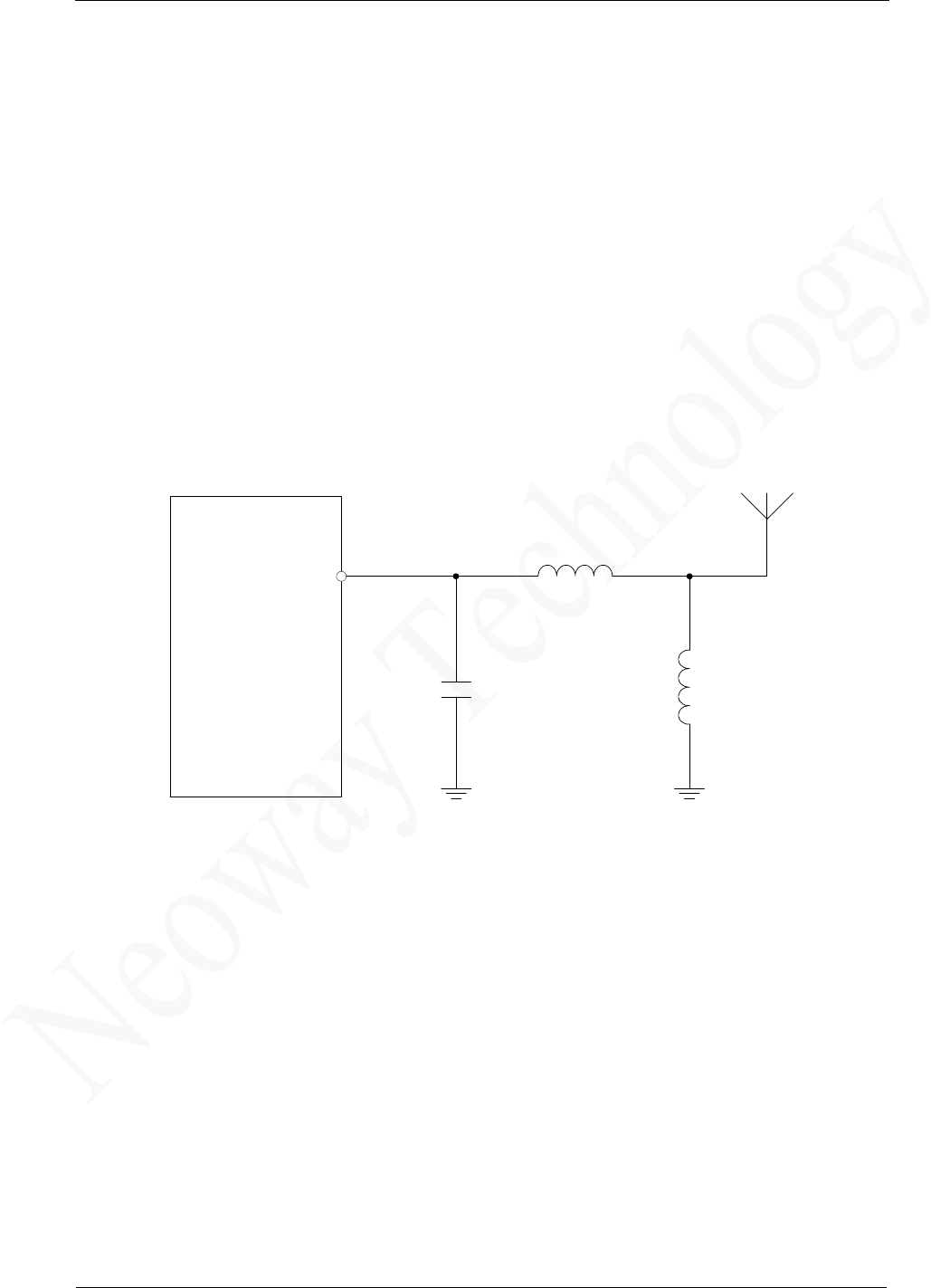
M590 GPRS Module Hardware User Guide
Copyright © Neoway Technology Co., Ltd 19
3.6 RF Interface
3.6.1 RF Design and PCB Layout
A 50 Ω antenna is required. VSWR ranges from 1.1 to 1.5. The antenna should be well matched to achieve
best performance. It should be installed far away from high speed logic circuits, DC/DC power, or any other
strong disturbing sources.
For multiple-layer PCB, the trace between the antenna pad of module and the antenna connector, should
have a 50 Ω characteristic impedance, and be as short as possible. The trace should be surrounded by ground
copper. Place plenty of via holes to connect this ground copper to main ground plane, at the copper edge.
If the trace between the module and connector has to be longer, or built-in antenna is used, a π-type
matching circuit should be needed, as shown in Figure 3-19. The types and values of C1, L1, and L2 should
be verified by testing using network analyzer instrument. If the characteristic impedance is well matched,
and VSWR requirement is met, just use a 0 Ω resistor for L1 and leave C1, L2 un-installed.
Avoid any other traces crossing the antenna trace on neighboring layer.
Figure 3-19 Reference design for antenna interface
On two-layer boards which cannot control resistance properly, the RF route should be as short and smooth
as possible and at a width of 1mm; the RF is 1 mm away from the ground.
Figure 3-20 shows a two-layer board application. The RF is connected to GSC RF connector through traces
on PCB, which is connected to the antenna via cable.
Remove the copper from the area of 2 mm in diameter around the RF testing point. Dig ground holes as
many as possible. Separate this area from the copper-removing area of the 21st pin by ground.
Ensure complete ground around the 20th pin in case that its signal is affected by other high-speed signals
(SIM signal, e.g.).
GPRS
Module
ANT
C1
GPRS_ANT
L2
L1
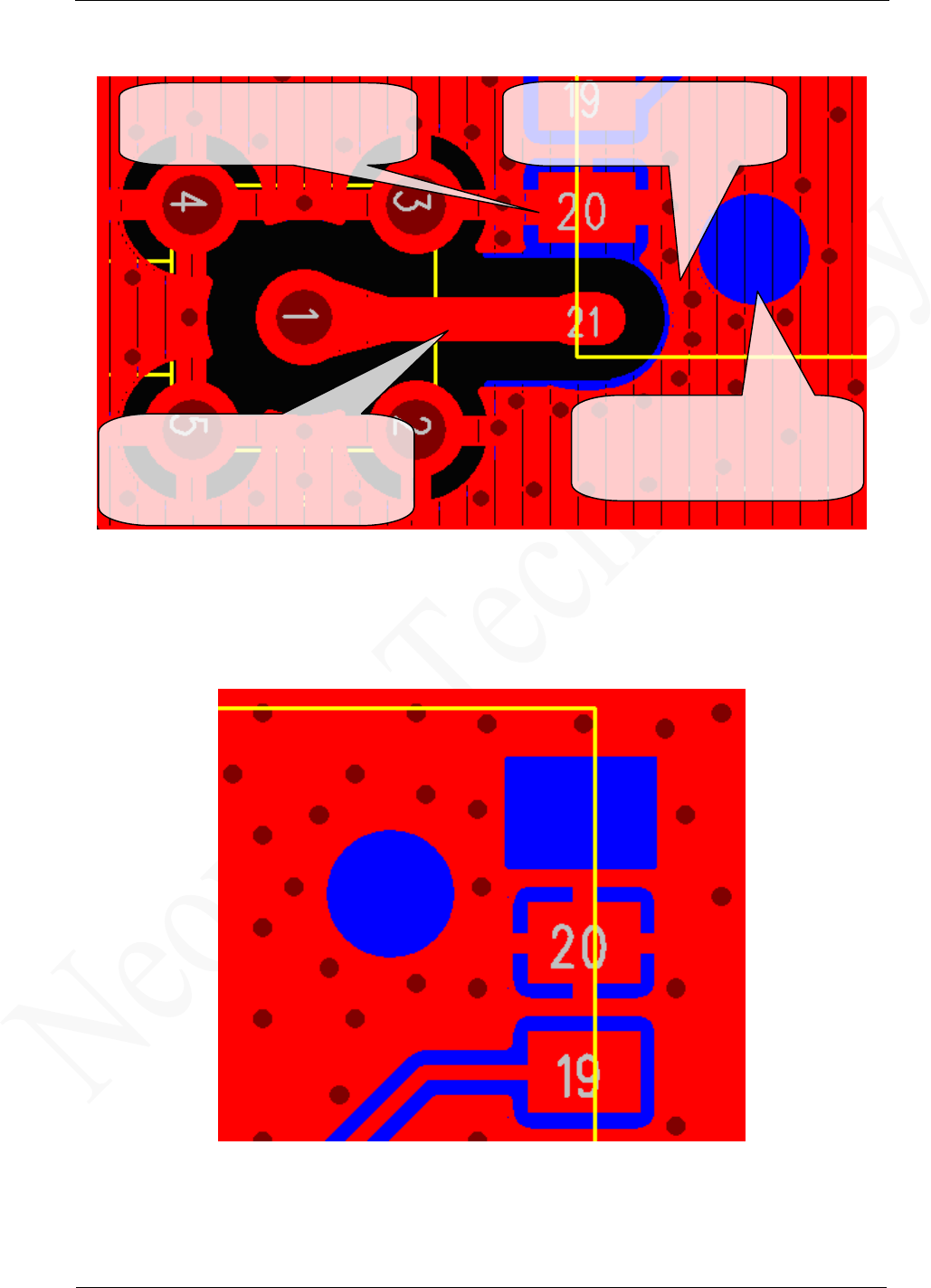
M590 GPRS Module Hardware User Guide
Copyright © Neoway Technology Co., Ltd 20
Figure 3-20 RF layout reference
If you use RF feeder to connect the module and the antenna (pin 21 is not used), remove the pad of the
21st pin and its adjuncts. Refer to Figure 3-21.
Figure 3-21 Reference RF design when pin 21 is not used
Ensure complete ground at both
sides of the 20th pin. Avoid
ground at only one side.
The RF route should be as short
and smooth as possible and at a
width of 1 mm; the RF is 1 mm
away from the ground.
Separate the copper-removing
area from the RF route by
ground.
Remove the copper from the
top layer of the RF testing point
(2mm in diameter). Dig ground
holes around this are.
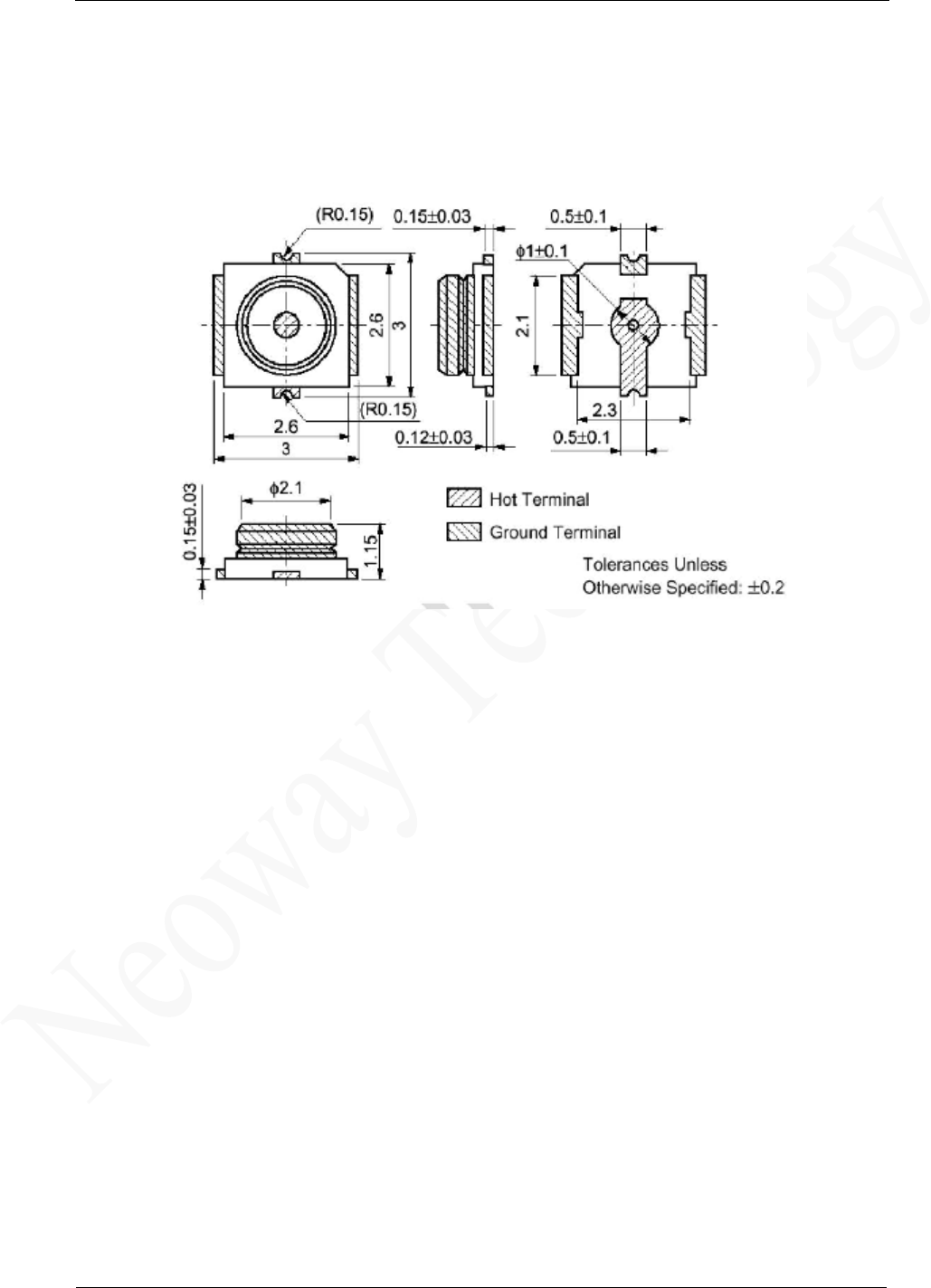
M590 GPRS Module Hardware User Guide
Copyright © Neoway Technology Co., Ltd 21
3.6.2 Recommended RF Connection
If you adopts RF cables for connections, the GSC RF connector MM9329-2700RA1 from Murata is
recommended. Figure 3-22 shows the encapsulation specifications.
Figure 3-22 Encapsulation specifications of Murata RF connector

M590 GPRS Module Hardware User Guide
Copyright © Neoway Technology Co., Ltd 22
4 Electric Features and Reliability
4.1 Electric Feature
Table 4-1 Electric feature of the module
Parameter Minimum Value Typical Value Maximum Value
VBAT Vin 3.5V 3.9V 4.3V
Iin / / 2A
VDD_EXT Vout
/ 2.8V /
Iout / / 50mA
DIO
Vout
2.3V 2.8V 3.1V
Iout / / 4mA
Vin -0.3V 0V 0.6V
Iin / / 22.5uA
If the voltage is too low, the module might fail to start. If the voltage is too high or there is a voltage burst
during the startup, the module might be damaged permanently.
If you use LDO or DC-DC to supply power for the module, ensure that it output at least 2 A current.
4.2 Temperature
Table 4-2 Temperature Feature
Module Status Minimum Value Typical Value Maximum Value
Working -40℃ 25℃ 85℃
Storage -45℃ 90℃
If the module works in temperature exceeding the thresholds, its RF performance (e.g. frequency
deviation or phase deviation) might be worse but it can still work properly.

M590 GPRS Module Hardware User Guide
Copyright © Neoway Technology Co., Ltd 23
4.3 Current
Table 4-3 Current feature
Parameter Testing Conditions Testing Result
(Average Current)
Testing voltage 3.9 V Agilent power supply /
Idle mode Set the instrument and power on the module. 18mA
Off leakage current Power on the module or use AT command to shut
the module down. 50uA
Average network
searching current
Set the instrument.
Start the module. Wait until the module registers the
instrument.
60mA
Sleep mode
On a live network, the module registers the network
and then enters the sleep mode. 1.7mA
Set the instrument properly (DRX=9) 1 mA
Voice service Maximum power level in full rate
mode
EGSM900 197.8mA
DCS1800 152.6mA
GPRS class 12
4Up/1Down@Gamma=3 EGSM900 417.6mA
DCS1800 303.1mA
1Up/4Down@Gamma=3 EGSM900 186.8 mA
DCS1800 144.2mA
The data in the above table is typical values obtained during tests in lab. It might be a little bit different in
manufacturing. Also, the test results might be various due to different settings or testing methods.
4.4 ESDProtection
Electronics need to pass sever ESD tests. The following table shows the ESD capability of key pins of our
module. It is recommended that you add ESD protection to those pins in accordance to the application to
ensure your product quality when designing your products.
Humility: 45%
Temperature: 25℃
Table 4-4 ESD feature of the module
Testing Point Contact Discharge Air Discharge
VBAT ±8KV ±15KV
GND ±8KV ±15KV

M590 GPRS Module Hardware User Guide
Copyright © Neoway Technology Co., Ltd 24
ANT ±8KV ±15KV
Cover ±8KV ±15KV
URXD/UTXD ±4KV ±8KV
Others ±4KV ±8KV

M590 GPRS Module Hardware User Guide
Copyright © Neoway Technology Co., Ltd 25
5 RF Features
5.1 Work Band
Table 5-1 Work band
Work Band Uplink Downlink
EGSM900 880~915MHz 925~960MHz
DCS1800 1710~1785MHz 1805~1880MHz
5.2 Transmitting Power and Receiving Sensitivity
5.2.1 Transmitting Power
Table 5-2 Transmitting power (EGSM900)
PCL Transmitting Power Threshold Range
5 33dBm ±2 dBm
6 31dBm ±3dBm
7 29 dBm ±3dBm
8 27 dBm ±3dBm
9 25 dBm ±3dBm
10 23 dBm ±3dBm
11 21 dBm ±3dBm
12 19 dBm ±3dBm
13 17 dBm ±3dBm
14 15 dBm ±3dBm
15 13 dBm ±5dBm
16 11 dBm ±5dBm
17 9 dBm ±5dBm
18 7 dBm ±5dBm
19 5 dBm ±5dBm
Table 5-3 Transmitting power (DCS1800)
PCL Transmitting Power Threshold Range
0 30 dBm ±2 dBm
1 28 dBm ±3dBm

M590 GPRS Module Hardware User Guide
Copyright © Neoway Technology Co., Ltd 26
2 26 dBm ±3dBm
3 24 dBm ±3dBm
4 22 dBm ±3dBm
5 20 dBm ±3dBm
6 18 dBm ±3dBm
7 16 dBm ±3dBm
8 14 dBm ±3dBm
9 12 dBm ±3dBm
10 10 dBm ±4Bm
11 8 dBm ±4Bm
12 6 dBm ±4Bm
13 4 dBm ±4dBm
14 2 dBm ±5dBm
15 0 dBm ±5 dBm
5.2.2 Receiving Sensitivity
Band Typical
GSM800&EGSM900 <-107 dBm
DCS1800&PCS1900 <-107 dBm
The data in the above tables is obtained by connecting the module to RF test instrument (e.g.
CMU200, CWM500, or Agilent8960) in lab tests. It is for reference only.
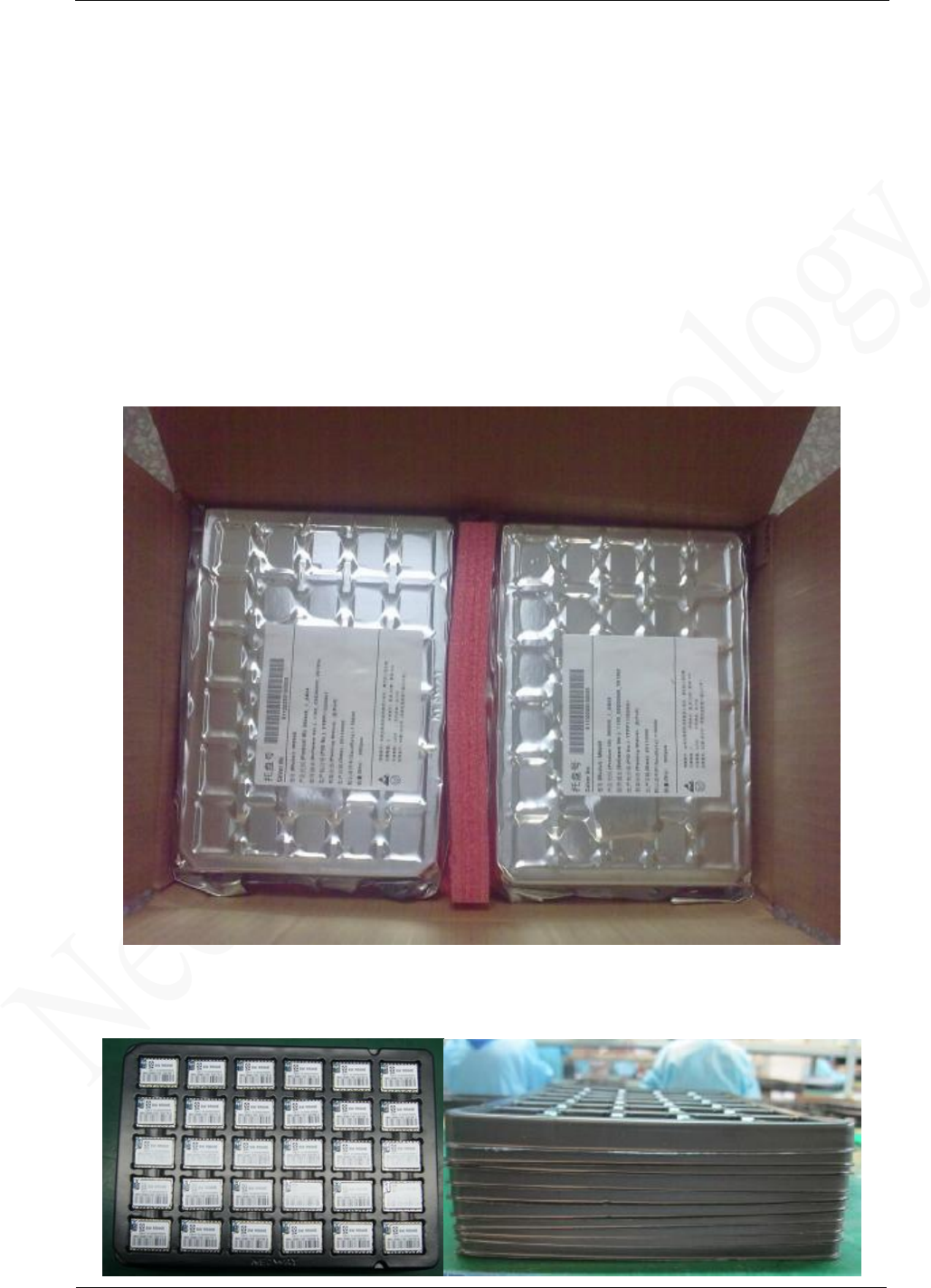
M590 GPRS Module Hardware User Guide
Copyright © Neoway Technology Co., Ltd 27
6 Mounting the Module onto the Application Board
M590 is compatible with industrial standard reflow profile for lead-free SMT process.
The reflow profile is process dependent, so the following recommendation is just a start point guideline:
l Only one flow is supported.
l Quality of the solder joint depends on the solder volume. Minimum of 0.15mm stencil thickness is
recommended.
l Use bigger aperture size of the stencil than actual pad size.
l Use a low-residue, no-clean type solder paste.
7 Package
M590modules are packaged in sealed bags on delivery to guarantee a long shelf life. Package the modules
again in case of opening for any reasons.
Neoway adopts trays to hold our modules to facilitate mounting. You can just put the tray in fixed
direction on your machine. For more details about the storage and mounting of our modules, refer
toReflow Soldering Guide for Neoway SMD Modules V1.2.

M590 GPRS Module Hardware User Guide
Copyright © Neoway Technology Co., Ltd 28
8 Abbreviations
ADC Analog-Digital Converter
AFC Automatic Frequency Control
AGC Automatic Gain Control
AMR Acknowledged multirate (speech coder)
CSD Circuit Switched Data
CPU Central Processing Unit
DAI Digital Audio interface
DAC Digital-to-Analog Converter
DCE Data Communication Equipment
DSP Digital Signal Processor
DTE Data Terminal Equipment
DTMF Dual Tone Multi-Frequency
DTR Data Terminal Ready
EFR Enhanced Full Rate
EGSM Enhanced GSM
EMC Electromagnetic Compatibility
EMI Electro Magnetic Interference
ESD Electronic Static Discharge
ETS European Telecommunication Standard
FDMA Frequency Division Multiple Access
FR Full Rate
GPRS General Packet Radio Service
GSM Global Standard for Mobile Communications
HR Half Rate
IC Integrated Circuit
IMEI International Mobile Equipment Identity
LCD Liquid Crystal Display
LED Light Emitting Diode
MS Mobile Station
PCB Printed Circuit Board
PCS Personal Communication System

M590 GPRS Module Hardware User Guide
Copyright © Neoway Technology Co., Ltd 29
RAM Random Access Memory
RF Radio Frequency
ROM Read-only Memory
RMS Root Mean Square
RTC Real Time Clock
SIM Subscriber Identification Module
SMS Short Message Service
SRAM Static Random Access Memory
TA Terminal adapter
TDMA Time Division Multiple Access
UART Universal asynchronous receiver-transmitter
VSWR Voltage Standing Wave Ratio
Modular Approal:
The M590 module is designed to comply with the FCC statement. FCC ID is PJ7-125X. The host
system using M590, should have label indicated it contain modular’s FCC ID PJ7-125X.
This radio module must not installed to co-locate and operating simultaneously with other radios in host
system , additional testing and equipment authorization may be required to operating simultaneously with
other radio.
RF warning for Mobile device:
This equipment complies with FCC radiation exposure limits set forth for an
uncontrolled environment. This equipment should be installed and operated with
minimum distance 20cm between the radiator & your body.
§ 15.19 Labelling requirements.
This device complies with part 15 of the FCC Rules. Operation is subject to the
following two conditions: (1) This device may not cause harmful interference, and (2)
this device must accept any interference received, including interference that may
cause undesired operation.
§ 15.21 Information to user.
Any Changes or modifications not expressly approved by the party responsible for compliance could vo
id the user's authority to operate the equipment.
§ 15.105 Information to the user.
Note: This equipment has been tested and found to comply with the limits for a Class B digital device,
pursuant to part 15 of the FCC Rules. These limits are designed to provide reasonable protection against
harmful interference in a residential installation. This equipment generates uses and can radiate radio f
requency energy and, if not installed and used in accordance with the instructions, may cause harmful in

M590 GPRS Module Hardware User Guide
Copyright © Neoway Technology Co., Ltd 30
terference to radio communications. However, there is no guarantee that interference will not occur in a
particular installation. If this equipment does cause harmful interference to radio or television reception,
which can be determined by turning the equipment off and on, the user is encouraged to try to correct t
he interference by one or more of the following measures:
-Reorient or relocate the receiving antenna.
-Increase the separation between the equipment and receiver.
-Connect the equipment into an outlet on a circuit different from that to which the receiver is connected.
-Consult the dealer or an experienced radio/TV technician for help.